

Creating a Comprehensive Business Plan Rubric
A well-structured business plan is a foundational document for any entrepreneurial venture, serving as a roadmap to guide your business to success. It provides clarity on your business goals, strategies, and financial projections, making it an essential tool for attracting investors and stakeholders. However, evaluating the quality and completeness of a business plan can be challenging, especially when dealing with multiple plans. This is where a business plan rubric comes into play. It’s a systematic and objective way to assess business plans consistently.
How to Create a Comprehensive Business Plan Rubric
1. define your objectives.
Start by identifying the objectives of your business plan rubric. What do you want to assess and measure in the business plans? Your objectives may include evaluating market research, financial projections, marketing strategies, or overall clarity and coherence. Make sure your objectives align with the key components of a well-rounded business plan.
2. Establish Criteria
For each objective, establish specific criteria or factors that you will evaluate. For instance, if you’re assessing market research, your criteria might include the depth of market analysis, competitor research, and target audience insights. Clearly define the criteria for each objective.
3. Assign Weightings
Not all criteria are equally important. Assign weightings to each criterion based on its significance. Weightings reflect the relative importance of different elements in the business plan. For example, financial projections may carry more weight than a company’s historical background.
4. Develop a Scoring System
Create a scoring system for each criterion. You can use a numerical scale (e.g., 1-5, 1-10) or a descriptive scale (e.g., poor, fair, good, excellent). This system allows you to provide a quantitative assessment for each criterion.
5. Provide Clear Descriptions
For each criterion and level on the scoring system, provide clear descriptions of what each level represents. This ensures consistent and objective evaluation. Avoid vague descriptions to prevent subjectivity.
6. Consider the Overall Structure
Include an assessment of the business plan’s overall structure and presentation. Elements to consider might include readability, use of headings, and formatting. A well-organized and visually appealing plan often indicates a more professional and thoughtful approach.
7. Test Your Rubric
Before applying your rubric to assess real business plans, test it with a few sample plans to ensure that it’s clear, fair, and effective. Make any necessary adjustments based on your testing.
8. Evaluate Business Plans
Once your rubric is ready, you can begin evaluating business plans. Review each plan against the criteria, assign scores, and calculate the final scores based on the weightings.
9. Provide Feedback
After assessing the plans, offer constructive feedback to the entrepreneurs or teams behind them. Highlight strengths and weaknesses, and offer recommendations for improvement. This feedback can be invaluable for the plan’s creators.
10. Maintain Consistency
Consistency is key in using a business plan rubric. Ensure that different assessors apply the rubric consistently, and if possible, discuss and calibrate your rubric assessments with other evaluators to maintain fairness and objectivity.
11. Use the Results
The results from your business plan rubric can help you make informed decisions about which plans align best with your investment or support criteria. Plans with higher scores are likely more well-prepared and have thoroughly considered various aspects of their business.
Business Rubric Example
Here are a few examples of criteria that could be included in a business plan rubric along with a corresponding scoring system:
- Identification of target market (5 points)
- Thoroughness of competitor analysis (5 points)
- Assessment of market trends and growth potential (5 points)
- Realistic revenue forecasts (5 points)
- Comprehensive cost analysis (5 points)
- Clear understanding of profit margins (5 points)
- Coherent and effective marketing plan (5 points)
- Utilization of digital marketing tools (5 points)
- Identification of key marketing channels (5 points)
- Description of unique value proposition (5 points)
- Clarity in product development roadmap (5 points)
- Assessment of potential market demand (5 points)
- Demonstrated expertise and experience (5 points)
- Coherence and complementary skills of the team (5 points)
- Clarity in roles and responsibilities (5 points)
- Identification of potential risks (5 points)
- Comprehensive risk mitigation strategies (5 points)
- Contingency plans for identified risks (5 points)
- Clarity and coherence of the business plan structure (5 points)
- Use of appropriate visuals and graphics (5 points)
- Professionalism and readability of the document (5 points)
For each of the criteria listed above, a scoring system can be implemented using a scale such as:
- 1-5 scale (1 being Poor, 5 being Excellent)
- 1-10 scale (1 being Low, 10 being High)
- Descriptive scale (Poor, Fair, Good, Excellent)
In summary, a well-structured business plan rubric is a valuable tool for evaluating and comparing multiple business plans. It provides objectivity, consistency, and fairness in assessing the quality and completeness of these plans, helping you make informed decisions when considering investments or partnerships. This business plan rubric can help assessors evaluate various business plans consistently and objectively, providing a comprehensive overview of the strengths and weaknesses of each plan and aiding in making informed decisions regarding potential investments or collaborations.

- Design for Business
- Most Recent
- Presentations
- Infographics
- Data Visualizations
- Forms and Surveys
- Video & Animation
- Case Studies
- Digital Marketing
- Design Inspiration
- Visual Thinking
- Product Updates
- Visme Webinars
- Artificial Intelligence
How to Write a Business Plan: Beginner’s Guide (& Templates)

Written by: Chloe West

Thinking about starting a business? One of the first steps you’ll need to take is to write a business plan. A business plan can help guide you through your financial planning, marketing strategy, unique selling point and more.
Making sure you start your new business off on the right foot is key, and we’re here to help. We’ve put together this guide to help you write your first business plan. Or, you can skip the guide and dive right into a business plan template .
Ready to get started?
Here’s a short selection of 8 easy-to-edit business plan templates you can edit, share and download with Visme. View more templates below:

8-Step Process for Writing a Business Plan
What is a business plan, why is a business plan important, step #1: write your executive summary, step #2: put together your company description, step #3: conduct your market analysis, step #4: research your competition, step #5: outline your products or services, step #6: summarize your financial plan, step #7: determine your marketing strategy, step #8: showcase your organizational chart, 14 business plan templates to help you get started.
A business plan is a document that helps potential new business owners flesh out their business idea and put together a bird’s eye view of their business. Writing a business plan is an essential step in any startup’s ideation process.
Business plans help determine demographics, market analysis, competitive analysis, financial projections, new products or services, and so much more.
Each of these bits of information are important to have on hand when you’re trying to start a business or pitching investors for funds.
Here’s an example of a business plan that you can customize to incorporate your own business information.

We’re going to walk you through some of the most important parts of your business plan as well as how to write your own business plan in 8 easy steps.
If you’re in the beginning stages of starting a business , you might be wondering if it’s really worth your time to write out your business plan.
We’re here to tell you that it is.
A business plan is important for a number of reasons, but mostly because it helps to set you up for success right from the start.
Here are four reasons to prove to you why you need to start your business off on the right foot with a plan.
Reason #1: Set Realistic Goals and Milestones
Putting together a business plan helps you to set your objectives for growth and make realistic goals while you begin your business.
By laying out each of the steps you need to take in order to build a successful business, you’re able to be more reasonable about what your timeline is for achieving everything as well as what your financial projections are.
The best way to set goals is using the SMART goals guidelines, outlined below.

Reason #2: Grow Your Business Faster
Having a business plan helps you be more organized and strategic, improving the overall performance of your business as you start out. In fact, one study found that businesses with a plan grow 30% faster than businesses that don’t.
Doesn’t that sound reason enough alone to start out your business venture with a solidified plan? We thought so too, but we’ve still got two more reasons.
Reason #3: Minimize Risk
Starting a new business is uncharted territory. However, when you start with a roadmap for your journey, it makes it easier to see success and minimize the risks that come with startups.
Minimize risk and maximize profitability by documenting the most important parts of your business planning.
Reason #4: Secure Funding
And finally, our last reason that business plans are so important is that if you plan to pitch investors for funding for your new venture, they’re almost always going to want to see a detailed business plan before deciding whether or not to invest.
You can easily create your business plan and investor pitch deck right here with Visme. Just sign up for a free account below to get started.
Hey executives! Looking to cut design costs?
- Spend less time on presentations and more time strategizing
- Ensure your brand looks and feels visually consistent across all your organization's documents
- Impress clients and stakeholders with boardroom ready presentations
Sign up. It’s free.

The executive summary is a brief overview of your entire business plan, giving anyone who reads through your document a quick understanding of what they’re going to learn about your business idea.
However, you need to remember that some of the people who are going to read your business plan don’t want to or have time to read the entire thing. So your executive summary needs to incorporate all of the most important aspects of your plan.
Here’s an example of an executive summary from a business plan template you can customize and turn into your own.

Your executive summary should include:
- Key objective(s)
- Market research
- Competitor information
- Products/services
- Value proposition
- Overview of your financial plan
- How you’re going to actually start your business
One thing to note is that you should actually write your executive summary after the rest of your business plan so that you can properly summarize everything you’ve already created.
So at this point, simply leave a page blank for your executive summary so you can come back to it at the end of your business plan.

The next step is to write out a full description of your business and its core offerings. This section of your business plan should include your mission statement and objectives, along with your company history or overview.
In this section, you may also briefly describe your business formation details from a legal perspective.
Mission Statement
Don’t spend too much time trying to craft this. Your mission statement is a simple “why” you started this business. What are you trying to achieve? Or what does your business solve?
This can be anything from one single quote or a paragraph, but it doesn’t need to be much longer than that. In fact, this could be very similar to your value proposition.

What are your goals? What do you plan to achieve in the first 90 days or one year of your business? What kind of impact do you hope to make on the market?
These are all good points to include in your objectives section so anyone reading your business plan knows upfront what you hope to achieve.
History or Overview
If you’re not launching a brand new business or if you’ve previously worked on another iteration of this business, let potential investors know the history of your company.
If not, simply provide an overview of your business, sharing what it does or what it will do.

Your third step is to conduct a market analysis so you know how your business will fit into its target market. This page in your business plan is simply meant to summarize your findings. Most of your time should be spent actually doing the research.
Your market analysis needs to look at things like:
- Market size, and if it’s grown in recent years or shrinking
- The segment of the market you plan to target
- Demographics and behavior of your target audience
- The demand for your product or service
- Your competitive advantage or differentiation strategy
- The average price of your product or service
Put together a summary of your market analysis and industry research in a 1-2 page format, like we see below.

Your next step is to conduct a competitive analysis. While you likely touched on this briefly during your market analysis, now is the time to do a deep dive so that you have a good grasp on what your competitors are doing and how they are generating customers.
Start by creating a profile of all your existing competitors, or at the very least, your closest competitors – the ones who are offering very similar products or services to you, or are in a similar vicinity (if you’re opening a brick and mortar store).
Focus on their strengths and what they’re doing really well so that you can emulate their best qualities in your own way. Then, look at their weaknesses and what your business can do better.
Take note of their current marketing strategy, including the outlets you see a presence, whether it’s on social media, you hear a radio ad, you see a TV ad, etc. You won’t always find all of their marketing channels, but see what you can find online and on their website.

After this, take a minute to identify potential competitors based on markets you might try out in the future, products or services you plan to add to your offerings, and more.
Then put together a page or two in your business plan that highlights your competitive advantage and how you’ll be successful breaking into the market.
Step five is to dedicate a page to the products or services that your business plans to offer.
Put together a quick list and explanation of what each of the initial product or service offerings will be, but steer clear of industry jargon or buzzwords. This should be written in plain language so anyone reading has a full understanding of what your business will do.

You can have a simple list like we see in the sample page above, or you can dive a little deeper. Depending on your type of business, it might be a good idea to provide additional information about what each product or service entails.
The next step is to work on the financial data of your new business. What will your overhead be? How will your business make money? What are your estimated expenses and profits over the first few months to a year? The expenses should cover all the spending whether they are recurring costs or just one-time LLC filing fees .
There is so much that goes into your financial plan for a new business, so this is going to take some time to compile. Especially because this section of your business plan helps potential cofounders or investors understand if the idea is even viable.

Your financial plan should include at least five major sections:
- Sales Forecast: The first thing you want to include is a forecast or financial projection of how much you think your business can sell over the next year or so. Break this down into the different products, services or facets of your business.
- Balance Sheet: This section is essentially a statement of your company’s financial position. It includes existing assets, liabilities and equity to demonstrate the company’s overall financial health.
- Income Statement: Also known as a profit and loss statement (P&L), this covers your projected expenses and revenue, showcasing whether your business will be profitable or not.
- Operating Budget: A detailed outline of your business’s income and expenses. This should showcase that your business is bringing in more than it’s spending.
- Cash Flow Statements: This tracks how much cash your business has at any given point, regardless of whether customers or clients have paid their bills or have 30-60+ days to do so.
While these are the most common financial statements, you may discover that there are other sections that you want to include or that lenders may want to see from you.
You can automate the process of looking through your documents with an OCR API , which will collect the data from all your financial statements and invoices.
The next step is coming up with a successful marketing plan so that you can actually get the word out about your business.
Throughout your business plan, you’ve already researched your competitors and your target market, both of which are major components of a good marketing strategy. You need to know who you’re marketing to, and you want to do it better than your competition.

On this page or throughout this section of your business plan, you need to focus on your chosen marketing channels and the types of marketing content you plan to create.
Start by taking a look at the channels that your competitors are on and make sure you have a good understanding of the demographics of each channel as well. You don’t want to waste time on a marketing channel that your target audience doesn’t use.
Then, create a list of each of your planned marketing avenues. It might look something like:
- Social media ( Facebook, Instagram, Pinterest)
- Email newsletter
- Digital ads
Depending on the type of business you’re starting, this list could change quite a bit — and that’s okay. There is no one-size-fits-all marketing strategy, and you need to find the one that brings in the highest number of potential customers.
Your last section will be all about your leadership and management team members. Showcasing that you have a solid team right from the start can make potential investors feel better about funding your venture.
You can easily put together an organizational chart like the one below, with the founder/CEO at the top and each of your team leaders underneath alongside the department they’re in charge of.

Simply add an organizational chart like this as a page into your overall business plan and make sure it matches the rest of your design to create a cohesive document.
If you want to create a good business plan that sets your new business up for success and attracts new investors, it’s a good idea to start with a template.
We’ve got 14 options below from a variety of different industries for you to choose from. You can customize every aspect of each template to fit your business branding and design preferences.
If you're pressed for time, Visme's AI business plan generator can churn out compelling business plans in minutes. Just input a detailed prompt, choose the design, and watch the tool generate your plan in a few seconds.
Template #1: Photography Business Plan Template

This feminine and minimalistic business plan template is perfect for getting started with any kind of creative business. Utilize this template to help outline the step-by-step process of getting your new business idea up and running.
Template #2: Real Estate Business Plan Template

Looking for a more modern business plan design? This template is perfect for plainly laying out each of your business plans in an easy-to-understand format. Adjust the red accents with your business’s colors to personalize this template.
Template #3: Nonprofit Business Plan Template

Creating a business and marketing plan for your nonprofit is still an essential step when you’re just starting out. You need to get the word out to increase donations and awareness for your cause.
Template #4: Restaurant Business Plan Template

If your business plan needs to rely heavily on showcasing photos of your products (like food), this template is perfect for you. Get potential investors salivating at the sight of your business plan, and they’re sure to provide the capital you need.
Template #5: Fashion Business Plan Template

Serifs are in. Utilize this template with stunning serif as all the headers to create a contemporary and trendy business plan design that fits your business. Adjust the colors to match your brand and easily input your own content.
Template #6: Daycare Business Plan Template

Creating a more kid-friendly or playful business? This business plan template has bold colors and design elements that will perfectly represent your business and its mission.
Use the pages you need, and remove any that you don’t. You can also duplicate pages and move the elements around to add even more content to your business plan.
Template #7: Consulting Business Plan Template

This classic business plan template is perfect for a consulting business that wants to use a stunning visual design to talk about its services.
Template #8: Coffee Shop Business Plan Template

Customize this coffee shop business plan template to match your own business idea. Adjust the colors to fit your brand or industry, replace photos with your own photography or stock photos that represent your business, and insert your own logo, fonts and colors throughout.
Template #9: SaaS Business Plan Template

A SaaS or service-based company also needs a solid business plan that lays out its financials, list of services, target market and more. This template is the perfect starting point.
Template #10: Small Business Plan Template

Every startup or small business needs to start out with a strong business plan in order to start off on the right foot and set yourself up for success. This template is an excellent starting point for any small business.
Template #11: Ecommerce Business Plan Template

An ecommerce business plan is ideal for planning out your pricing strategy of all of your online products, as well as the site you plan to use for setting up your store, whether WordPress, Shopify, Wix or something else.
Template #12: Startup Business Plan Template

Customize this template and make it your own! Edit and Download
This is another generic business plan template for any type of startup to customize. Switch out the content, fonts and colors to match your startup branding and increase brand equity.
Template #13: One-Page Business Plan Template

Want just a quick business plan to get your idea going before you bite the bullet and map out your entire plan? This one-page template is perfect for those just starting to flesh out a new business idea.
Template #14: Salon Business Plan Template

This salon business plan template is easy on the design and utilizes a light color scheme to put more focus on the actual content. You can use the design as is or keep it as a basis for your own design elements.
Create Your Own Business Plan Today
Ready to write your business plan? Once you’ve created all of the most important sections, get started with a business plan template to really wow your investors and organize your startup plan.
Design beautiful visual content you can be proud of.

Trusted by leading brands
Recommended content for you:

Create Stunning Content!
Design visual brand experiences for your business whether you are a seasoned designer or a total novice.
About the Author
Chloe West is the content marketing manager at Visme. Her experience in digital marketing includes everything from social media, blogging, email marketing to graphic design, strategy creation and implementation, and more. During her spare time, she enjoys exploring her home city of Charleston with her son.
11.4 The Business Plan
Learning objectives.
By the end of this section, you will be able to:
- Describe the different purposes of a business plan
- Describe and develop the components of a brief business plan
- Describe and develop the components of a full business plan
Unlike the brief or lean formats introduced so far, the business plan is a formal document used for the long-range planning of a company’s operation. It typically includes background information, financial information, and a summary of the business. Investors nearly always request a formal business plan because it is an integral part of their evaluation of whether to invest in a company. Although nothing in business is permanent, a business plan typically has components that are more “set in stone” than a business model canvas , which is more commonly used as a first step in the planning process and throughout the early stages of a nascent business. A business plan is likely to describe the business and industry, market strategies, sales potential, and competitive analysis, as well as the company’s long-term goals and objectives. An in-depth formal business plan would follow at later stages after various iterations to business model canvases. The business plan usually projects financial data over a three-year period and is typically required by banks or other investors to secure funding. The business plan is a roadmap for the company to follow over multiple years.
Some entrepreneurs prefer to use the canvas process instead of the business plan, whereas others use a shorter version of the business plan, submitting it to investors after several iterations. There are also entrepreneurs who use the business plan earlier in the entrepreneurial process, either preceding or concurrently with a canvas. For instance, Chris Guillebeau has a one-page business plan template in his book The $100 Startup . 48 His version is basically an extension of a napkin sketch without the detail of a full business plan. As you progress, you can also consider a brief business plan (about two pages)—if you want to support a rapid business launch—and/or a standard business plan.
As with many aspects of entrepreneurship, there are no clear hard and fast rules to achieving entrepreneurial success. You may encounter different people who want different things (canvas, summary, full business plan), and you also have flexibility in following whatever tool works best for you. Like the canvas, the various versions of the business plan are tools that will aid you in your entrepreneurial endeavor.
Business Plan Overview
Most business plans have several distinct sections ( Figure 11.16 ). The business plan can range from a few pages to twenty-five pages or more, depending on the purpose and the intended audience. For our discussion, we’ll describe a brief business plan and a standard business plan. If you are able to successfully design a business model canvas, then you will have the structure for developing a clear business plan that you can submit for financial consideration.
Both types of business plans aim at providing a picture and roadmap to follow from conception to creation. If you opt for the brief business plan, you will focus primarily on articulating a big-picture overview of your business concept.
The full business plan is aimed at executing the vision concept, dealing with the proverbial devil in the details. Developing a full business plan will assist those of you who need a more detailed and structured roadmap, or those of you with little to no background in business. The business planning process includes the business model, a feasibility analysis, and a full business plan, which we will discuss later in this section. Next, we explore how a business plan can meet several different needs.
Purposes of a Business Plan
A business plan can serve many different purposes—some internal, others external. As we discussed previously, you can use a business plan as an internal early planning device, an extension of a napkin sketch, and as a follow-up to one of the canvas tools. A business plan can be an organizational roadmap , that is, an internal planning tool and working plan that you can apply to your business in order to reach your desired goals over the course of several years. The business plan should be written by the owners of the venture, since it forces a firsthand examination of the business operations and allows them to focus on areas that need improvement.
Refer to the business venture throughout the document. Generally speaking, a business plan should not be written in the first person.
A major external purpose for the business plan is as an investment tool that outlines financial projections, becoming a document designed to attract investors. In many instances, a business plan can complement a formal investor’s pitch. In this context, the business plan is a presentation plan, intended for an outside audience that may or may not be familiar with your industry, your business, and your competitors.
You can also use your business plan as a contingency plan by outlining some “what-if” scenarios and exploring how you might respond if these scenarios unfold. Pretty Young Professional launched in November 2010 as an online resource to guide an emerging generation of female leaders. The site focused on recent female college graduates and current students searching for professional roles and those in their first professional roles. It was founded by four friends who were coworkers at the global consultancy firm McKinsey. But after positions and equity were decided among them, fundamental differences of opinion about the direction of the business emerged between two factions, according to the cofounder and former CEO Kathryn Minshew . “I think, naively, we assumed that if we kicked the can down the road on some of those things, we’d be able to sort them out,” Minshew said. Minshew went on to found a different professional site, The Muse , and took much of the editorial team of Pretty Young Professional with her. 49 Whereas greater planning potentially could have prevented the early demise of Pretty Young Professional, a change in planning led to overnight success for Joshua Esnard and The Cut Buddy team. Esnard invented and patented the plastic hair template that he was selling online out of his Fort Lauderdale garage while working a full-time job at Broward College and running a side business. Esnard had hundreds of boxes of Cut Buddies sitting in his home when he changed his marketing plan to enlist companies specializing in making videos go viral. It worked so well that a promotional video for the product garnered 8 million views in hours. The Cut Buddy sold over 4,000 products in a few hours when Esnard only had hundreds remaining. Demand greatly exceeded his supply, so Esnard had to scramble to increase manufacturing and offered customers two-for-one deals to make up for delays. This led to selling 55,000 units, generating $700,000 in sales in 2017. 50 After appearing on Shark Tank and landing a deal with Daymond John that gave the “shark” a 20-percent equity stake in return for $300,000, The Cut Buddy has added new distribution channels to include retail sales along with online commerce. Changing one aspect of a business plan—the marketing plan—yielded success for The Cut Buddy.
Link to Learning
Watch this video of Cut Buddy’s founder, Joshua Esnard, telling his company’s story to learn more.
If you opt for the brief business plan, you will focus primarily on articulating a big-picture overview of your business concept. This version is used to interest potential investors, employees, and other stakeholders, and will include a financial summary “box,” but it must have a disclaimer, and the founder/entrepreneur may need to have the people who receive it sign a nondisclosure agreement (NDA) . The full business plan is aimed at executing the vision concept, providing supporting details, and would be required by financial institutions and others as they formally become stakeholders in the venture. Both are aimed at providing a picture and roadmap to go from conception to creation.
Types of Business Plans
The brief business plan is similar to an extended executive summary from the full business plan. This concise document provides a broad overview of your entrepreneurial concept, your team members, how and why you will execute on your plans, and why you are the ones to do so. You can think of a brief business plan as a scene setter or—since we began this chapter with a film reference—as a trailer to the full movie. The brief business plan is the commercial equivalent to a trailer for Field of Dreams , whereas the full plan is the full-length movie equivalent.
Brief Business Plan or Executive Summary
As the name implies, the brief business plan or executive summary summarizes key elements of the entire business plan, such as the business concept, financial features, and current business position. The executive summary version of the business plan is your opportunity to broadly articulate the overall concept and vision of the company for yourself, for prospective investors, and for current and future employees.
A typical executive summary is generally no longer than a page, but because the brief business plan is essentially an extended executive summary, the executive summary section is vital. This is the “ask” to an investor. You should begin by clearly stating what you are asking for in the summary.
In the business concept phase, you’ll describe the business, its product, and its markets. Describe the customer segment it serves and why your company will hold a competitive advantage. This section may align roughly with the customer segments and value-proposition segments of a canvas.
Next, highlight the important financial features, including sales, profits, cash flows, and return on investment. Like the financial portion of a feasibility analysis, the financial analysis component of a business plan may typically include items like a twelve-month profit and loss projection, a three- or four-year profit and loss projection, a cash-flow projection, a projected balance sheet, and a breakeven calculation. You can explore a feasibility study and financial projections in more depth in the formal business plan. Here, you want to focus on the big picture of your numbers and what they mean.
The current business position section can furnish relevant information about you and your team members and the company at large. This is your opportunity to tell the story of how you formed the company, to describe its legal status (form of operation), and to list the principal players. In one part of the extended executive summary, you can cover your reasons for starting the business: Here is an opportunity to clearly define the needs you think you can meet and perhaps get into the pains and gains of customers. You also can provide a summary of the overall strategic direction in which you intend to take the company. Describe the company’s mission, vision, goals and objectives, overall business model, and value proposition.
Rice University’s Student Business Plan Competition, one of the largest and overall best-regarded graduate school business-plan competitions (see Telling Your Entrepreneurial Story and Pitching the Idea ), requires an executive summary of up to five pages to apply. 51 , 52 Its suggested sections are shown in Table 11.2 .
| Section | Description |
|---|---|
| Company summary | Brief overview (one to two paragraphs) of the problem, solution, and potential customers |
| Customer analysis | Description of potential customers and evidence they would purchase product |
| Market analysis | Size of market, target market, and share of market |
| Product or service | Current state of product in development and evidence it is feasible |
| Intellectual property | If applicable, information on patents, licenses, or other IP items |
| Competitive differentiation | Describe the competition and your competitive advantage |
| Company founders, management team, and/or advisor | Bios of key people showcasing their expertise and relevant experience |
| Financials | Projections of revenue, profit, and cash flow for three to five years |
| Amount of investment | Funding request and how funds will be used |
Are You Ready?
Create a brief business plan.
Fill out a canvas of your choosing for a well-known startup: Uber, Netflix, Dropbox, Etsy, Airbnb, Bird/Lime, Warby Parker, or any of the companies featured throughout this chapter or one of your choice. Then create a brief business plan for that business. See if you can find a version of the company’s actual executive summary, business plan, or canvas. Compare and contrast your vision with what the company has articulated.
- These companies are well established but is there a component of what you charted that you would advise the company to change to ensure future viability?
- Map out a contingency plan for a “what-if” scenario if one key aspect of the company or the environment it operates in were drastically is altered?
Full Business Plan
Even full business plans can vary in length, scale, and scope. Rice University sets a ten-page cap on business plans submitted for the full competition. The IndUS Entrepreneurs , one of the largest global networks of entrepreneurs, also holds business plan competitions for students through its Tie Young Entrepreneurs program. In contrast, business plans submitted for that competition can usually be up to twenty-five pages. These are just two examples. Some components may differ slightly; common elements are typically found in a formal business plan outline. The next section will provide sample components of a full business plan for a fictional business.
Executive Summary
The executive summary should provide an overview of your business with key points and issues. Because the summary is intended to summarize the entire document, it is most helpful to write this section last, even though it comes first in sequence. The writing in this section should be especially concise. Readers should be able to understand your needs and capabilities at first glance. The section should tell the reader what you want and your “ask” should be explicitly stated in the summary.
Describe your business, its product or service, and the intended customers. Explain what will be sold, who it will be sold to, and what competitive advantages the business has. Table 11.3 shows a sample executive summary for the fictional company La Vida Lola.
Executive Summary Component | Content |
|---|---|
The Concept | La Vida Lola is a food truck serving the best Latin American and Caribbean cuisine in the Atlanta region, particularly Puerto Rican and Cuban dishes, with a festive flair. La Vida Lola offers freshly prepared dishes from the mobile kitchen of the founding chef and namesake Lola González, a Duluth, Georgia, native who has returned home to launch her first venture after working under some of the world’s top chefs. La Vida Lola will cater to festivals, parks, offices, community and sporting events, and breweries throughout the region. |
Market Advantage | Latin food packed with flavor and flair is the main attraction of La Vida Lola. Flavors steeped in Latin American and Caribbean culture can be enjoyed from a menu featuring street foods, sandwiches, and authentic dishes from the González family’s Puerto Rican and Cuban roots. craving ethnic food experiences and are the primary customers, but anyone with a taste for delicious homemade meals in Atlanta can order. Having a native Atlanta-area resident returning to her hometown after working in restaurants around the world to share food with area communities offers a competitive advantage for La Vida Lola in the form of founding chef Lola González. |
Marketing | The venture will adopt a concentrated marketing strategy. The company’s promotion mix will comprise a mix of advertising, sales promotion, public relations, and personal selling. Much of the promotion mix will center around dual-language social media. |
Venture Team | The two founding members of the management team have almost four decades of combined experience in the restaurant and hospitality industries. Their background includes experience in food and beverage, hospitality and tourism, accounting, finance, and business creation. |
Capital Requirements | La Vida Lola is seeking startup capital of $50,000 to establish its food truck in the Atlanta area. An additional $20,000 will be raised through a donations-driven crowdfunding campaign. The venture can be up and running within six months to a year. |
Business Description
This section describes the industry, your product, and the business and success factors. It should provide a current outlook as well as future trends and developments. You also should address your company’s mission, vision, goals, and objectives. Summarize your overall strategic direction, your reasons for starting the business, a description of your products and services, your business model, and your company’s value proposition. Consider including the Standard Industrial Classification/North American Industry Classification System (SIC/NAICS) code to specify the industry and insure correct identification. The industry extends beyond where the business is located and operates, and should include national and global dynamics. Table 11.4 shows a sample business description for La Vida Lola.
Business Description | La Vida Lola will operate in the mobile food services industry, which is identified by SIC code 5812 Eating Places and NAICS code 722330 Mobile Food Services, which consist of establishments primarily engaged in preparing and serving meals and snacks for immediate consumption from motorized vehicles or nonmotorized carts. Ethnically inspired to serve a consumer base that craves more spiced Latin foods, La Vida Lola is an Atlanta-area food truck specializing in Latin cuisine, particularly Puerto Rican and Cuban dishes native to the roots of the founding chef and namesake, Lola González. La Vida Lola aims to spread a passion for Latin cuisine within local communities through flavorful food freshly prepared in a region that has embraced international eats. Through its mobile food kitchen, La Vida Lola plans to roll into parks, festivals, office buildings, breweries, and sporting and community events throughout the greater Atlanta metropolitan region. Future growth possibilities lie in expanding the number of food trucks, integrating food delivery on demand, and adding a food stall at an area food market. After working in noted restaurants for a decade, most recently under the famed chef José Andrés, chef Lola González returned to her hometown of Duluth, Georgia, to start her own venture. Although classically trained by top world chefs, it was González’s grandparents’ cooking of authentic Puerto Rican and Cuban dishes in their kitchen that influenced her profoundly. The freshest ingredients from the local market, the island spices, and her attention to detail were the spark that ignited Lola’s passion for cooking. To that end, she brings flavors steeped in Latin American and Caribbean culture to a flavorful menu packed full of street foods, sandwiches, and authentic dishes. Through reasonably priced menu items, La Vida Lola offers food that appeals to a wide range of customers, from millennial foodies to Latin natives and other locals with Latin roots. |
Industry Analysis and Market Strategies
Here you should define your market in terms of size, structure, growth prospects, trends, and sales potential. You’ll want to include your TAM and forecast the SAM . (Both these terms are discussed in Conducting a Feasibility Analysis .) This is a place to address market segmentation strategies by geography, customer attributes, or product orientation. Describe your positioning relative to your competitors’ in terms of pricing, distribution, promotion plan, and sales potential. Table 11.5 shows an example industry analysis and market strategy for La Vida Lola.
Industry Analysis and Market Strategy | According to ’ first annual report from the San Francisco-based Off The Grid, a company that facilitates food markets nationwide, the US food truck industry alone is projected to grow by nearly 20 percent from $800 million in 2017 to $985 million in 2019. Meanwhile, an report shows the street vendors’ industry with a 4.2 percent annual growth rate to reach $3.2 billion in 2018. Food truck and street food vendors are increasingly investing in specialty, authentic ethnic, and fusion food, according to the report. Although the report projects demand to slow down over the next five years, it notes there are still opportunities for sustained growth in major metropolitan areas. The street vendors industry has been a particular bright spot within the larger food service sector. The industry is in a growth phase of its life cycle. The low overhead cost to set up a new establishment has enabled many individuals, especially specialty chefs looking to start their own businesses, to own a food truck in lieu of opening an entire restaurant. Off the Grid’s annual report indicates the average typical initial investment ranges from $55,000 to $75,000 to open a mobile food truck. The restaurant industry accounts for $800 billion in sales nationwide, according to data from the National Restaurant Association. Georgia restaurants brought in a total of $19.6 billion in 2017, according to figures from the Georgia Restaurant Association. There are approximately 12,000 restaurants in the metro Atlanta region. The Atlanta region accounts for almost 60 percent of the Georgia restaurant industry. The SAM is estimated to be approximately $360 million. The mobile food/street vendor industry can be segmented by types of customers, types of cuisine (American, desserts, Central and South American, Asian, mixed ethnicity, Greek Mediterranean, seafood), geographic location and types (mobile food stands, mobile refreshment stands, mobile snack stands, street vendors of food, mobile food concession stands). Secondary competing industries include chain restaurants, single location full-service restaurants, food service contractors, caterers, fast food restaurants, and coffee and snack shops. The top food truck competitors according to the , the daily newspaper in La Vida Lola’s market, are Bento Bus, Mix’d Up Burgers, Mac the Cheese, The Fry Guy, and The Blaxican. Bento Bus positions itself as a Japanese-inspired food truck using organic ingredients and dispensing in eco-friendly ware. The Blaxican positions itself as serving what it dubs “Mexican soul food,” a fusion mashup of Mexican food with Southern comfort food. After years of operating a food truck, The Blaxican also recently opened its first brick-and-mortar restaurant. The Fry Guy specializes in Belgian-style street fries with a variety of homemade dipping sauces. These three food trucks would be the primary competition to La Vida Lola, since they are in the “ethnic food” space, while the other two offer traditional American food. All five have established brand identities and loyal followers/customers since they are among the industry leaders as established by “best of” lists from area publications like the . Most dishes from competitors are in the $10–$13 price range for entrees. La Vida Lola dishes will range from $6 to $13. One key finding from Off the Grid’s report is that mobile food has “proven to be a powerful vehicle for catalyzing diverse entrepreneurship” as 30 percent of mobile food businesses are immigrant owned, 30 percent are women owned, and 8 percent are LGBTQ owned. In many instances, the owner-operator plays a vital role to the brand identity of the business as is the case with La Vida Lola. Atlanta has also tapped into the nationwide trend of food hall-style dining. These food halls are increasingly popular in urban centers like Atlanta. On one hand, these community-driven areas where food vendors and retailers sell products side by side are secondary competitors to food trucks. But they also offer growth opportunities for future expansion as brands solidify customer support in the region. The most popular food halls in Atlanta are Ponce City Market in Midtown, Krog Street Market along the BeltLine trail in the Inman Park area, and Sweet Auburn Municipal Market downtown Atlanta. In addition to these trends, Atlanta has long been supportive of international cuisine as Buford Highway (nicknamed “BuHi”) has a reputation for being an eclectic food corridor with an abundance of renowned Asian and Hispanic restaurants in particular. The Atlanta region is home to a thriving Hispanic and Latinx population, with nearly half of the region’s foreign-born population hailing from Latin America. There are over half a million Hispanic and Latin residents living in metro Atlanta, with a 150 percent population increase predicted through 2040. The median age of metro Atlanta Latinos is twenty-six. La Vida Lola will offer authentic cuisine that will appeal to this primary customer segment. La Vida Lola must contend with regulations from towns concerning operations of mobile food ventures and health regulations, but the Atlanta region is generally supportive of such operations. There are many parks and festivals that include food truck vendors on a weekly basis. |
Competitive Analysis
The competitive analysis is a statement of the business strategy as it relates to the competition. You want to be able to identify who are your major competitors and assess what are their market shares, markets served, strategies employed, and expected response to entry? You likely want to conduct a classic SWOT analysis (Strengths Weaknesses Opportunities Threats) and complete a competitive-strength grid or competitive matrix. Outline your company’s competitive strengths relative to those of the competition in regard to product, distribution, pricing, promotion, and advertising. What are your company’s competitive advantages and their likely impacts on its success? The key is to construct it properly for the relevant features/benefits (by weight, according to customers) and how the startup compares to incumbents. The competitive matrix should show clearly how and why the startup has a clear (if not currently measurable) competitive advantage. Some common features in the example include price, benefits, quality, type of features, locations, and distribution/sales. Sample templates are shown in Figure 11.17 and Figure 11.18 . A competitive analysis helps you create a marketing strategy that will identify assets or skills that your competitors are lacking so you can plan to fill those gaps, giving you a distinct competitive advantage. When creating a competitor analysis, it is important to focus on the key features and elements that matter to customers, rather than focusing too heavily on the entrepreneur’s idea and desires.
Operations and Management Plan
In this section, outline how you will manage your company. Describe its organizational structure. Here you can address the form of ownership and, if warranted, include an organizational chart/structure. Highlight the backgrounds, experiences, qualifications, areas of expertise, and roles of members of the management team. This is also the place to mention any other stakeholders, such as a board of directors or advisory board(s), and their relevant relationship to the founder, experience and value to help make the venture successful, and professional service firms providing management support, such as accounting services and legal counsel.
Table 11.6 shows a sample operations and management plan for La Vida Lola.
| Operations and Management Plan Category | Content |
|---|---|
Key Management Personnel | The key management personnel consist of Lola González and Cameron Hamilton, who are longtime acquaintances since college. The management team will be responsible for funding the venture as well as securing loans to start the venture. The following is a summary of the key personnel backgrounds. Chef Lola González has worked directly in the food service industry for fifteen years. While food has been a lifelong passion learned in her grandparents’ kitchen, chef González has trained under some of the top chefs in the world, most recently having worked under the James Beard Award-winning chef José Andrés. A native of Duluth, Georgia, chef González also has an undergraduate degree in food and beverage management. Her value to the firm is serving as “the face” and company namesake, preparing the meals, creating cuisine concepts, and running the day-to-day operations of La Vida Lola. Cameron Hamilton has worked in the hospitality industry for over twenty years and is experienced in accounting and finance. He has a master of business administration degree and an undergraduate degree in hospitality and tourism management. He has opened and managed several successful business ventures in the hospitality industry. His value to the firm is in business operations, accounting, and finance. |
Advisory Board | During the first year of operation, the company intends to keep a lean operation and does not plan to implement an advisory board. At the end of the first year of operation, the management team will conduct a thorough review and discuss the need for an advisory board. |
Supporting Professionals | Stephen Ngo, Certified Professional Accountant (CPA), of Valdosta, Georgia, will provide accounting consulting services. Joanna Johnson, an attorney and friend of chef González, will provide recommendations regarding legal services and business formation. |
Marketing Plan
Here you should outline and describe an effective overall marketing strategy for your venture, providing details regarding pricing, promotion, advertising, distribution, media usage, public relations, and a digital presence. Fully describe your sales management plan and the composition of your sales force, along with a comprehensive and detailed budget for the marketing plan. Table 11.7 shows a sample marketing plan for La Vida Lola.
| Marketing Plan Category | Content |
|---|---|
Overview | La Vida Lola will adopt a concentrated marketing strategy. The company’s promotion mix will include a mix of advertising, sales promotion, public relations, and personal selling. Given the target millennial foodie audience, the majority of the promotion mix will be centered around social media platforms. Various social media content will be created in both Spanish and English. The company will also launch a crowdfunding campaign on two crowdfunding platforms for the dual purpose of promotion/publicity and fundraising. |
Advertising and Sales Promotion | As with any crowdfunding social media marketing plan, the first place to begin is with the owners’ friends and family. Utilizing primarily Facebook/Instagram and Twitter, La Vida Lola will announce the crowdfunding initiative to their personal networks and prevail upon these friends and family to share the information. Meanwhile, La Vida Lola needs to focus on building a community of backers and cultivating the emotional draw of becoming part of the La Vida Lola family. To build a crowdfunding community via social media, La Vida Lola will routinely share its location, daily if possible, on both Facebook, Instagram, and Twitter. Inviting and encouraging people to visit and sample their food can rouse interest in the cause. As the campaign is nearing its goal, it would be beneficial to offer a free food item to backers of a specific level, say $50, on one specific day. Sharing this via social media in the day or two preceding the giveaway and on the day of can encourage more backers to commit. Weekly updates of the campaign and the project as a whole are a must. Facebook and Twitter updates of the project coupled with educational information sharing helps backers feel part of the La Vida Lola community. Finally, at every location where La Vida Lola is serving its food, signage will notify the public of their social media presence and the current crowdfunding campaign. Each meal will be accompanied by an invitation from the server for the patron to visit the crowdfunding site and consider donating. Business cards listing the social media and crowdfunding information will be available in the most visible location, likely the counter. Before moving forward with launching a crowdfunding campaign, La Vida Lola will create its website. The website is a great place to establish and share the La Vida Lola brand, vision, videos, menus, staff, and events. It is also a great source of information for potential backers who are unsure about donating to the crowdfunding campaigns. The website will include these elements: . Address the following questions: Who are you? What are the guiding principles of La Vida Lola? How did the business get started? How long has La Vida Lola been in business? Include pictures of chef González. List of current offerings with prices. Will include promotional events and locations where customers can find the truck for different events. Steps will be taken to increase social media followers prior to launching the crowdfunding campaign. Unless a large social media following is already established, a business should aggressively push social media campaigns a minimum of three months prior to the crowdfunding campaign launch. Increasing social media following prior to the campaign kickoff will also allow potential donors to learn more about La Vida Lola and foster relationship building before attempting to raise funds. |
Facebook Content and Advertising | The key piece of content will be the campaign pitch video, reshared as a native Facebook upload. A link to the crowdfunding campaigns can be included in the caption. Sharing the same high-quality video published on the campaign page will entice fans to visit Kickstarter to learn more about the project and rewards available to backers. |
Crowdfunding Campaigns | Foodstart was created just for restaurants, breweries, cafés, food trucks, and other food businesses, and allows owners to raise money in small increments. It is similar to Indiegogo in that it offers both flexible and fixed funding models and charges a percentage for successful campaigns, which it claims to be the lowest of any crowdfunding platform. It uses a reward-based system rather than equity, where backers are offered rewards or perks resulting in “low-cost capital and a network of people who now have an incentive to see you succeed.” Foodstart will host La Vida Lola’s crowdfunding campaigns for the following reasons: (1) It caters to their niche market; (2) it has less competition from other projects which means that La Vida Lola will stand out more and not get lost in the shuffle; and (3) it has/is making a name/brand for itself which means that more potential backers are aware of it. La Vida Lola will run a simultaneous crowdfunding campaign on Indiegogo, which has broader mass appeal. |
Publicity | Social media can be a valuable marketing tool to draw people to the Foodstarter and Indiegogo crowdfunding pages. It provides a means to engage followers and keep funders/backers updated on current fundraising milestones. The first order of business is to increase La Vida Lola’s social media presence on Facebook, Instagram, and Twitter. Establishing and using a common hashtag such as #FundLola across all platforms will promote familiarity and searchability, especially within Instagram and Twitter. Hashtags are slowly becoming a presence on Facebook. The hashtag will be used in all print collateral. La Vida Lola will need to identify social influencers—others on social media who can assist with recruiting followers and sharing information. Existing followers, family, friends, local food providers, and noncompetitive surrounding establishments should be called upon to assist with sharing La Vida Lola’s brand, mission, and so on. Cross-promotion will further extend La Vida Lola’s social reach and engagement. Influencers can be called upon to cross promote upcoming events and specials. The crowdfunding strategy will utilize a progressive reward-based model and establish a reward schedule such as the following: In addition to the publicity generated through social media channels and the crowdfunding campaign, La Vida Lola will reach out to area online and print publications (both English- and Spanish-language outlets) for feature articles. Articles are usually teased and/or shared via social media. Reaching out to local broadcast stations (radio and television) may provide opportunities as well. La Vida Lola will recruit a social media intern to assist with developing and implementing a social media content plan. Engaging with the audience and responding to all comments and feedback is important for the success of the campaign. Some user personas from segmentation to target in the campaign: |
Financial Plan
A financial plan seeks to forecast revenue and expenses; project a financial narrative; and estimate project costs, valuations, and cash flow projections. This section should present an accurate, realistic, and achievable financial plan for your venture (see Entrepreneurial Finance and Accounting for detailed discussions about conducting these projections). Include sales forecasts and income projections, pro forma financial statements ( Building the Entrepreneurial Dream Team , a breakeven analysis, and a capital budget. Identify your possible sources of financing (discussed in Conducting a Feasibility Analysis ). Figure 11.19 shows a template of cash-flow needs for La Vida Lola.
Entrepreneur In Action
Laughing man coffee.
Hugh Jackman ( Figure 11.20 ) may best be known for portraying a comic-book superhero who used his mutant abilities to protect the world from villains. But the Wolverine actor is also working to make the planet a better place for real, not through adamantium claws but through social entrepreneurship.
A love of java jolted Jackman into action in 2009, when he traveled to Ethiopia with a Christian humanitarian group to shoot a documentary about the impact of fair-trade certification on coffee growers there. He decided to launch a business and follow in the footsteps of the late Paul Newman, another famous actor turned philanthropist via food ventures.
Jackman launched Laughing Man Coffee two years later; he sold the line to Keurig in 2015. One Laughing Man Coffee café in New York continues to operate independently, investing its proceeds into charitable programs that support better housing, health, and educational initiatives within fair-trade farming communities. 55 Although the New York location is the only café, the coffee brand is still distributed, with Keurig donating an undisclosed portion of Laughing Man proceeds to those causes (whereas Jackman donates all his profits). The company initially donated its profits to World Vision, the Christian humanitarian group Jackman accompanied in 2009. In 2017, it created the Laughing Man Foundation to be more active with its money management and distribution.
- You be the entrepreneur. If you were Jackman, would you have sold the company to Keurig? Why or why not?
- Would you have started the Laughing Man Foundation?
- What else can Jackman do to aid fair-trade practices for coffee growers?
What Can You Do?
Textbooks for change.
Founded in 2014, Textbooks for Change uses a cross-compensation model, in which one customer segment pays for a product or service, and the profit from that revenue is used to provide the same product or service to another, underserved segment. Textbooks for Change partners with student organizations to collect used college textbooks, some of which are re-sold while others are donated to students in need at underserved universities across the globe. The organization has reused or recycled 250,000 textbooks, providing 220,000 students with access through seven campus partners in East Africa. This B-corp social enterprise tackles a problem and offers a solution that is directly relevant to college students like yourself. Have you observed a problem on your college campus or other campuses that is not being served properly? Could it result in a social enterprise?
Work It Out
Franchisee set out.
A franchisee of East Coast Wings, a chain with dozens of restaurants in the United States, has decided to part ways with the chain. The new store will feature the same basic sports-bar-and-restaurant concept and serve the same basic foods: chicken wings, burgers, sandwiches, and the like. The new restaurant can’t rely on the same distributors and suppliers. A new business plan is needed.
- What steps should the new restaurant take to create a new business plan?
- Should it attempt to serve the same customers? Why or why not?
This New York Times video, “An Unlikely Business Plan,” describes entrepreneurial resurgence in Detroit, Michigan.
- 48 Chris Guillebeau. The $100 Startup: Reinvent the Way You Make a Living, Do What You Love, and Create a New Future . New York: Crown Business/Random House, 2012.
- 49 Jonathan Chan. “What These 4 Startup Case Studies Can Teach You about Failure.” Foundr.com . July 12, 2015. https://foundr.com/4-startup-case-studies-failure/
- 50 Amy Feldman. “Inventor of the Cut Buddy Paid YouTubers to Spark Sales. He Wasn’t Ready for a Video to Go Viral.” Forbes. February 15, 2017. https://www.forbes.com/sites/forbestreptalks/2017/02/15/inventor-of-the-cut-buddy-paid-youtubers-to-spark-sales-he-wasnt-ready-for-a-video-to-go-viral/#3eb540ce798a
- 51 Jennifer Post. “National Business Plan Competitions for Entrepreneurs.” Business News Daily . August 30, 2018. https://www.businessnewsdaily.com/6902-business-plan-competitions-entrepreneurs.html
- 52 “Rice Business Plan Competition, Eligibility Criteria and How to Apply.” Rice Business Plan Competition . March 2020. https://rbpc.rice.edu/sites/g/files/bxs806/f/2020%20RBPC%20Eligibility%20Criteria%20and%20How%20to%20Apply_23Oct19.pdf
- 53 “Rice Business Plan Competition, Eligibility Criteria and How to Apply.” Rice Business Plan Competition. March 2020. https://rbpc.rice.edu/sites/g/files/bxs806/f/2020%20RBPC%20Eligibility%20Criteria%20and%20How%20to%20Apply_23Oct19.pdf; Based on 2019 RBPC Competition Rules and Format April 4–6, 2019. https://rbpc.rice.edu/sites/g/files/bxs806/f/2019-RBPC-Competition-Rules%20-Format.pdf
- 54 Foodstart. http://foodstart.com
- 55 “Hugh Jackman Journey to Starting a Social Enterprise Coffee Company.” Giving Compass. April 8, 2018. https://givingcompass.org/article/hugh-jackman-journey-to-starting-a-social-enterprise-coffee-company/
This book may not be used in the training of large language models or otherwise be ingested into large language models or generative AI offerings without OpenStax's permission.
Want to cite, share, or modify this book? This book uses the Creative Commons Attribution License and you must attribute OpenStax.
Access for free at https://openstax.org/books/entrepreneurship/pages/1-introduction
- Authors: Michael Laverty, Chris Littel
- Publisher/website: OpenStax
- Book title: Entrepreneurship
- Publication date: Jan 16, 2020
- Location: Houston, Texas
- Book URL: https://openstax.org/books/entrepreneurship/pages/1-introduction
- Section URL: https://openstax.org/books/entrepreneurship/pages/11-4-the-business-plan
© Jun 26, 2024 OpenStax. Textbook content produced by OpenStax is licensed under a Creative Commons Attribution License . The OpenStax name, OpenStax logo, OpenStax book covers, OpenStax CNX name, and OpenStax CNX logo are not subject to the Creative Commons license and may not be reproduced without the prior and express written consent of Rice University.
Simple Business Plan Templates
By Joe Weller | April 2, 2020
- Share on Facebook
- Share on LinkedIn
Link copied
In this article, we’ve compiled a variety of simple business plan templates, all of which are free to download in PDF, Word, and Excel formats.
On this page, you’ll find a one-page business plan template , a simple business plan for startups , a small-business plan template , a business plan outline , and more. We also include a business plan sample and the main components of a business plan to help get you started.
Simple Business Plan Template

Download Simple Business Plan Template
This simple business plan template lays out each element of a traditional business plan to assist you as you build your own, and it provides space to add financing information for startups seeking funding. You can use and customize this simple business plan template to fit the needs for organizations of any size.
One-Page Business Plan Template

Download One-Page Business Plan Template
Excel | Word | PDF | Smartsheet
Use this one-page business plan to document your key ideas in an organized manner. The template can help you create a high-level view of your business plan, and it provides easy scannability for stakeholders. You can use this one-page plan as a reference to build a more detailed blueprint for your business.
For additional single page plans, take a look at " One-Page Business Plan Templates with a Quick How-To Guide ."
Simple Fill-in-the-Blank Business Plan Template

Download Simple Fill-in-the-Blank Business Plan Template
Use this fill-in-the-blank business plan template to guide you as you build your business plan. Each section comes pre-filled with sample content, with space to add customized verbiage relevant to your product or service.
For additional free, downloadable resources, visit " Free Fill-In-the-Blank Business Plan Templates ."
Simple Business Plan for Startup

Download Startup Business Plan Template — Word
This business plan template is designed with a startup business in mind and contains the essential elements needed to convey key product or service details to investors and stakeholders. Keep all your information organized with this template, which provides space to include an executive summary, a company overview, competitive analysis, a marketing strategy, financial data, and more. For additional resources, visit " Free Startup Business Plan Templates and Examples ."
Simple Small-Business Plan Template

Download Simple Small-Business Plan Template
This template walks you through each component of a small-business plan, including the company background, the introduction of the management team, market analysis, product or service offerings, a financial plan, and more. This template also comes with a built-in table of contents to keep your plan in order, and it can be customized to fit your requirements.

Lean Business Plan Template

Download Lean Business Plan Template
This lean business plan template is a stripped-down version of a traditional business plan that provides only the most essential aspects. Briefly outline your company and industry overview, along with the problem you are solving, as well as your unique value proposition, target market, and key performance metrics. There is also room to list out a timeline of key activities.
Simple Business Plan Outline Template

Download Simple Business Plan Outline Template
Word | PDF
Use this simple business plan outline as a basis to create your own business plan. This template contains 11 sections, including a title page and a table of contents, which details what each section should cover in a traditional business plan. Simplify or expand this outline to create the foundation for a business plan that fits your business needs.
Simple Business Planning Template with Timeline

Download Simple Business Planning Template with Timeline
Excel | Smartsheet
This template doubles as a project plan and timeline to track progress as you develop your business plan. This business planning template enables you to break down your work into phases and provides room to add key tasks and dates for each activity. Easily fill in the cells according to the start and end dates to create a visual timeline, as well as to ensure your plan stays on track.
Simple Business Plan Rubric Template

Download Simple Business Plan Rubric
Excel | Word | PDF | Smartsheet
Once you complete your business plan, use this business plan rubric template to assess and score each component of your plan. This rubric helps you identify elements of your plan that meet or exceed requirements and pinpoint areas where you need to improve or further elaborate. This template is an invaluable tool to ensure your business plan clearly defines your goals, objectives, and plan of action in order to gain buy-in from potential investors, stakeholders, and partners.
Basic Business Plan Sample

Download Basic Business Plan Sample
This business plan sample serves as an example of a basic business plan that contains all the traditional components. The sample provides a model of what a business plan might look like for a fictional food truck business. Reference this sample as you develop your own business plan.
For additional resources to help support your business planning efforts, check out “ Free Strategic Planning Templates .”
Main Components of a Business Plan
The elements you include in your business plan will depend on your product or service offerings, as well as the size and needs of your business.
Below are the components of a standard business plan and details you should include in each section:
- Company name and contact information
- Website address
- The name of the company or individual viewing the presentation
- Table of Contents
- Company background and purpose
- Mission and vision statement
- Management team introduction
- Core product and service offerings
- Target customers and segments
- Marketing plan
- Competitive analysis
- Unique value proposition
- Financial plan (and requirements, if applicable)
- Business and industry overview
- Historical timeline of your business
- Offerings and the problem they solve
- Current alternatives
- Competitive advantage
- Market size
- Target market segment(s)
- Projected volume and value of sales compared to competitors
- Differentiation from competitors
- Pricing strategy
- Marketing channels
- Promotional plan
- Distribution methods
- Legal structure of your business
- Names of founders, owners, advisors, etc.
- Management team’s roles, relevant experience, and compensation plan
- Staffing requirements and training plans
- Physical location(s) of your business
- Additional physical requirements (e.g., warehouse, specialized equipment, facilities, etc.)
- Production workflow
- Raw materials and sourcing methods
- Projected income statement
- Projected cash flow statement
- Projected balance sheet
- Break-even analysis
- Charts and graphs
- Market research and competitive analysis
- Information about your industry
- Information about your offerings
- Samples of marketing materials
- Other supporting materials
Tips for Creating a Business Plan
It’s easy to feel overwhelmed at the thought of putting together a business plan. Below, you’ll find top tips to help simplify the process as you develop your own plan.
- Use a business plan template (you can choose from the variety above), or refer to the previous section to create a standard outline for your plan.
- Modify your outline to reflect the requirements of your specific business. If you use a standard business plan outline, remove sections that aren’t relevant to you or aren’t necessary to run your business.
- Gather all the information you currently have about your business first, and then use that information to fill out each section in your plan outline.
- Use your resources and conduct additional research to fill in the remaining gaps. (Note: It isn’t necessary to fill out your plan in order, but the executive summary needs to be completed last, as it summarizes the key points in your plan.)
- Ensure your plan clearly communicates the relationship between your marketing, sales, and financial objectives.
- Provide details in your plan that illustrate your strategic plan of action, looking forward three to five years.
- Revisit your plan regularly as strategies and objectives evolve.
- What product or service are we offering?
- Who is the product or service for?
- What problem does our product or service offering solve?
- How will we get the product or service to our target customers?
- Why is our product or service better than the alternatives?
- How can we outperform our competitors?
- What is our unique value proposition?
- When will things get done, and who is responsible for doing them?
- If you need to obtain funding, how will you use the funding?
- When are payments due, and when do payments come in?
- What is the ultimate purpose of your business?
- When do you expect to be profitable?
To identify which type of business plan you should write, and for more helpful tips, take a look at our guide to writing a simple business plan .
Benefits of Using a Business Plan Template
Creating a business plan can be very time-consuming, especially if you aren’t sure where to begin. Finding the right template for your business needs can be beneficial for a variety of reasons.
Using a business plan template — instead of creating your plan from scratch — can benefit you in the following ways:
- Enables you to immediately write down your thoughts and ideas in an organized manner
- Provides structure to help outline your plan
- Saves time and valuable resources
- Helps ensure you don’t miss essential details
Limitations of a Business Plan Template
A business plan template can be convenient, but it has its drawbacks — especially if you use a template that doesn’t fit the specific needs of your business.
Below are some limitations of using a business plan template:
- Each business is unique and needs a business plan that reflects that. A template may not fit your needs.
- A template may restrict collaboration with other team members on different aspects of the plan’s development (sales, marketing, and accounting teams).
- Multiple files containing different versions of the plan may be stored in more than one place.
- You still have to manually create charts and graphs to add to the plan to support your strategy.
- Updates to the plan, spreadsheets, and supporting documents have to be made in multiple places (all documents may not update in real time as changes are made).
Improve Your Business Plan with Real-Time Work Management in Smartsheet
Empower your people to go above and beyond with a flexible platform designed to match the needs of your team — and adapt as those needs change.
The Smartsheet platform makes it easy to plan, capture, manage, and report on work from anywhere, helping your team be more effective and get more done. Report on key metrics and get real-time visibility into work as it happens with roll-up reports, dashboards, and automated workflows built to keep your team connected and informed.
When teams have clarity into the work getting done, there’s no telling how much more they can accomplish in the same amount of time. Try Smartsheet for free, today.
Discover why over 90% of Fortune 100 companies trust Smartsheet to get work done.
WTO / Business / Tracking / 40 Free Rubric Templates – Examples – Word, PDF
40 Free Rubric Templates – Examples – Word, PDF
A rubric template is a printable grading tool that defines scoring criteria for evaluating the performance of a student or employee and giving feedback, which is grading.
It is typically presented as a matrix that indicates the different levels of achievement (quality) in terms of performance and understanding.
It will state the teacher’s or employer’s expectations and the different levels of effectiveness in fulfilling those expectations. Its main components are areas of assessment (tasks), evaluation criteria (dimensions), performance levels (scale), and descriptions of the evaluation criteria or dimensions. They are used to assess and grade term papers, presentations, project reports, essays, the success of projects, and other particular assignments given to students or employees.
How are the rubric templates useful to a teacher or employer? Primarily, it provides a uniform framework and language for assessment. This way, performance quality can be defined and graded based on merit. They are also crucial in defining organizational standards as they indicate and define the characteristics of the expected level of performance.
Teachers and employers can then communicate to students and employees where they can go and how they will get there in terms of performance. In addition, they reduce the time and simplify the assessment and grading exercise. Rubrics can also justify feedback; why the teacher or employer graded the individual’s performance as they did.
Areas in which such templates are used include:
- Job interview scoring
- Decision-making
- General math projects
- Basic analytics, etc.
Editable Rubic Templates
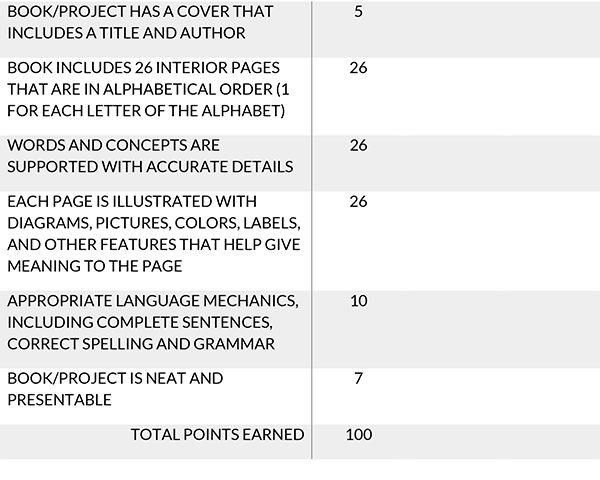
Rubric Template Types
When selecting a template, it is best to use one that can effectively meet the assessment needs at hand. The two common types are analytic and holistic rubrics. Below are the different types of templates:
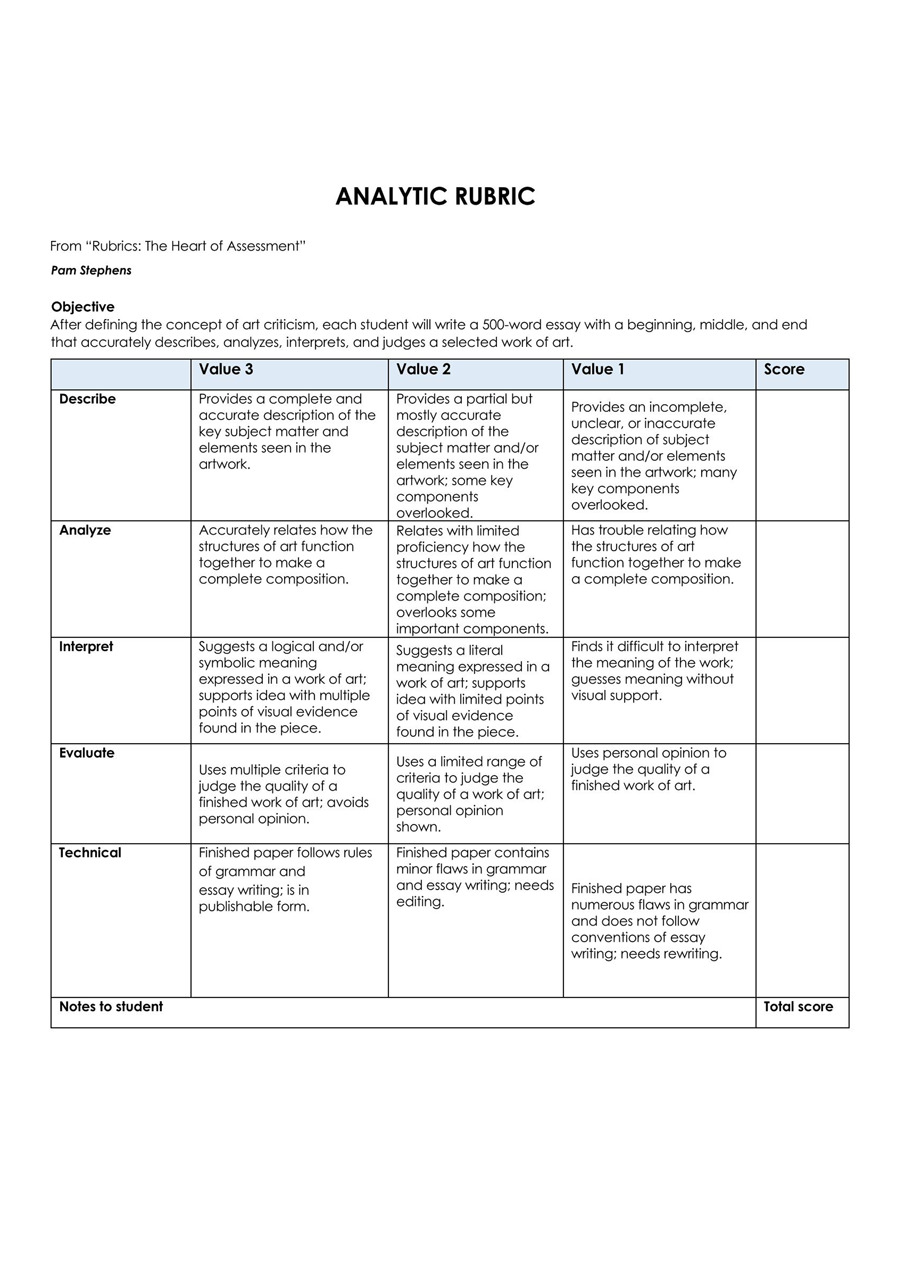
Analytic rubrics evaluate and grade an assignment or work at each performance level. As a result, each performance level gets a separate score which typically requires at least two characteristics of that performance level to be assessed.
Download: Microsoft Word (.docx)
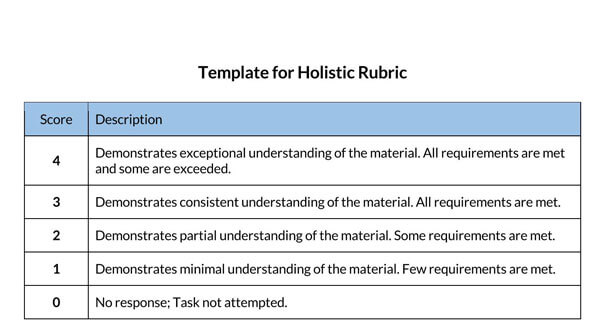
A holistic rubric provides a generalized assessment and score for the assignment. It gives the overall student's or employee's performance based on all the criteria assessed. Holistic rubrics are suited for quick assessments and large group scoring. However, they are confined in that they are not detailed as they do not show specific performances at each level.
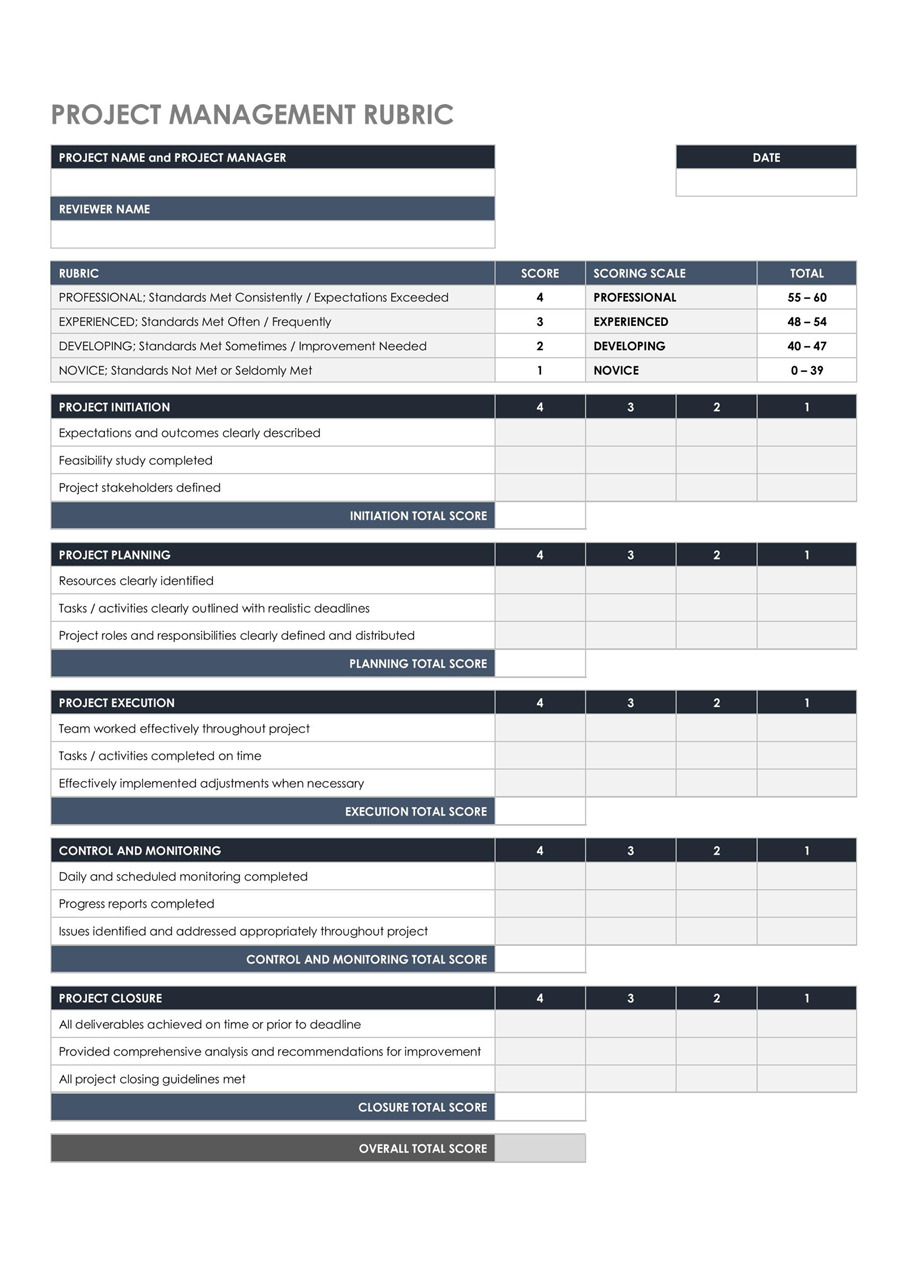
Rubrics are also used in project management to evaluate performance. The criteria used in project management rubrics are project phases, key objectives, and project milestones. The success metrics or indicators of each criterion are then listed as characteristics of levels of performance. A rating scale is used to measure performance.
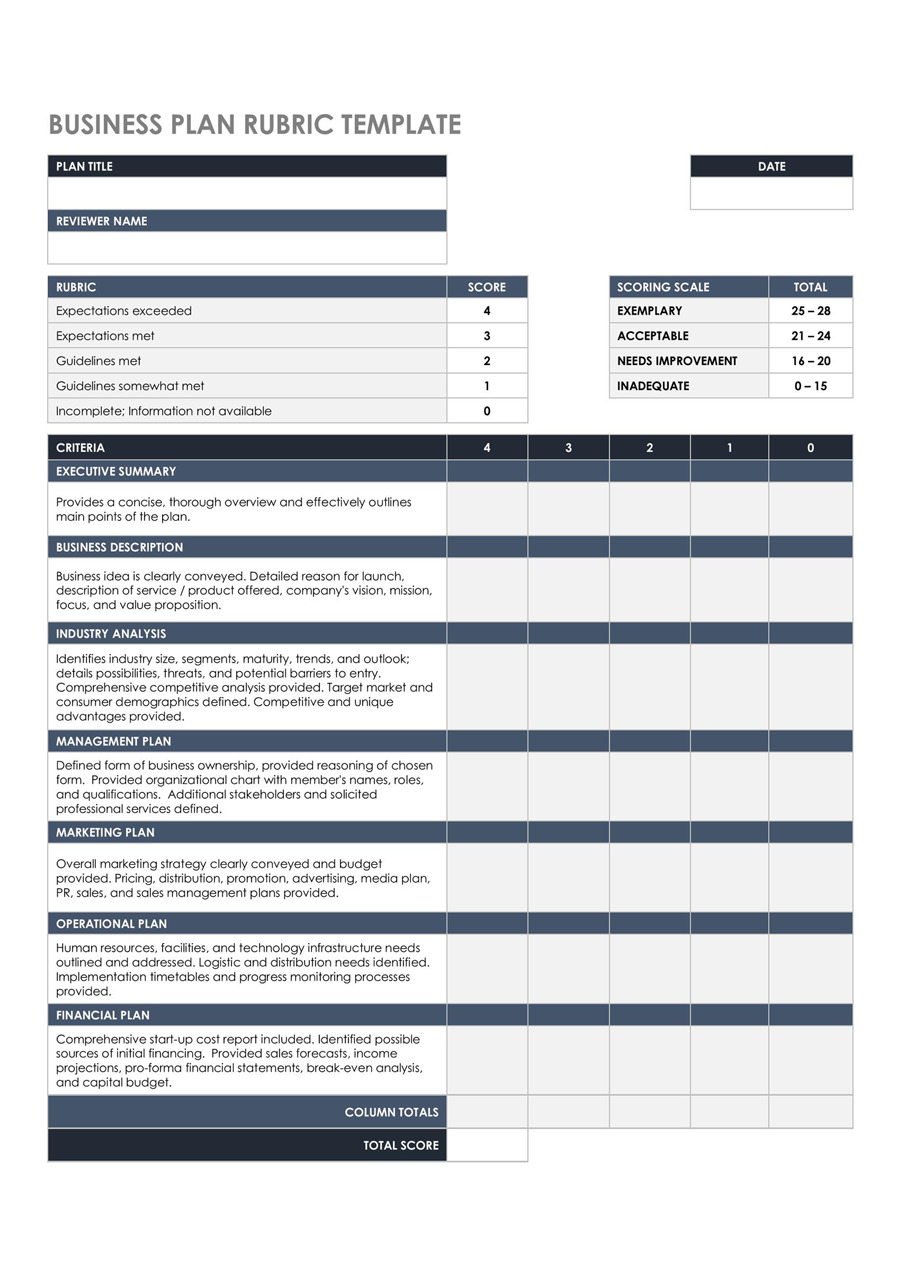
The performance of a business plan can be assessed using a rubrics template. Components of the business plan such as mission statement, market analysis, operational plan, financial plan are used as criteria and are rated based on their quality. A business plan rubric template helps identify the strengths and weaknesses of a business plan before presentation or execution.
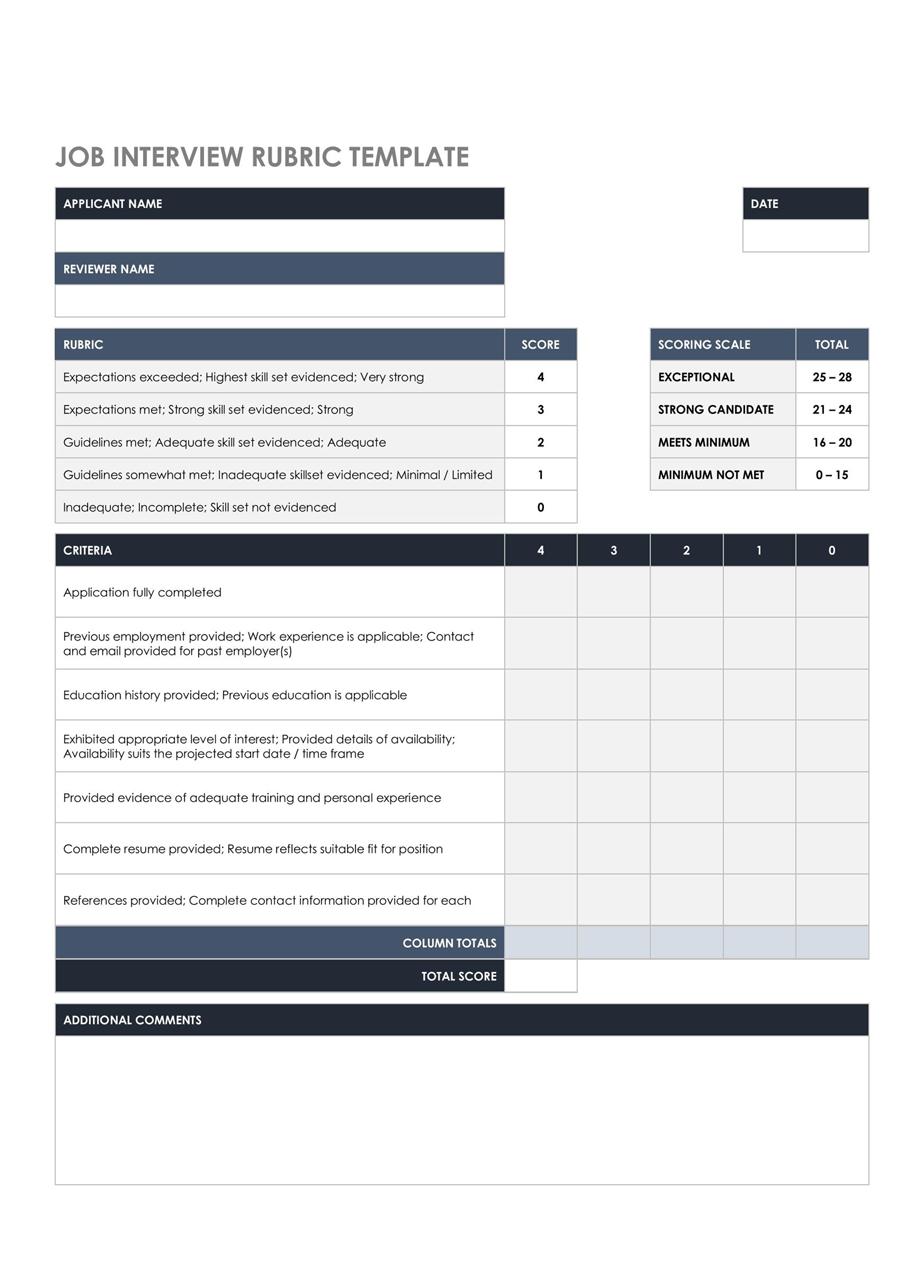
Job interviewers are popularly known to use rubrics to assess and score interviewees. Job qualifications and requirements such as academic qualification, professional experience, skills, and references can be used as criteria for evaluating performance.
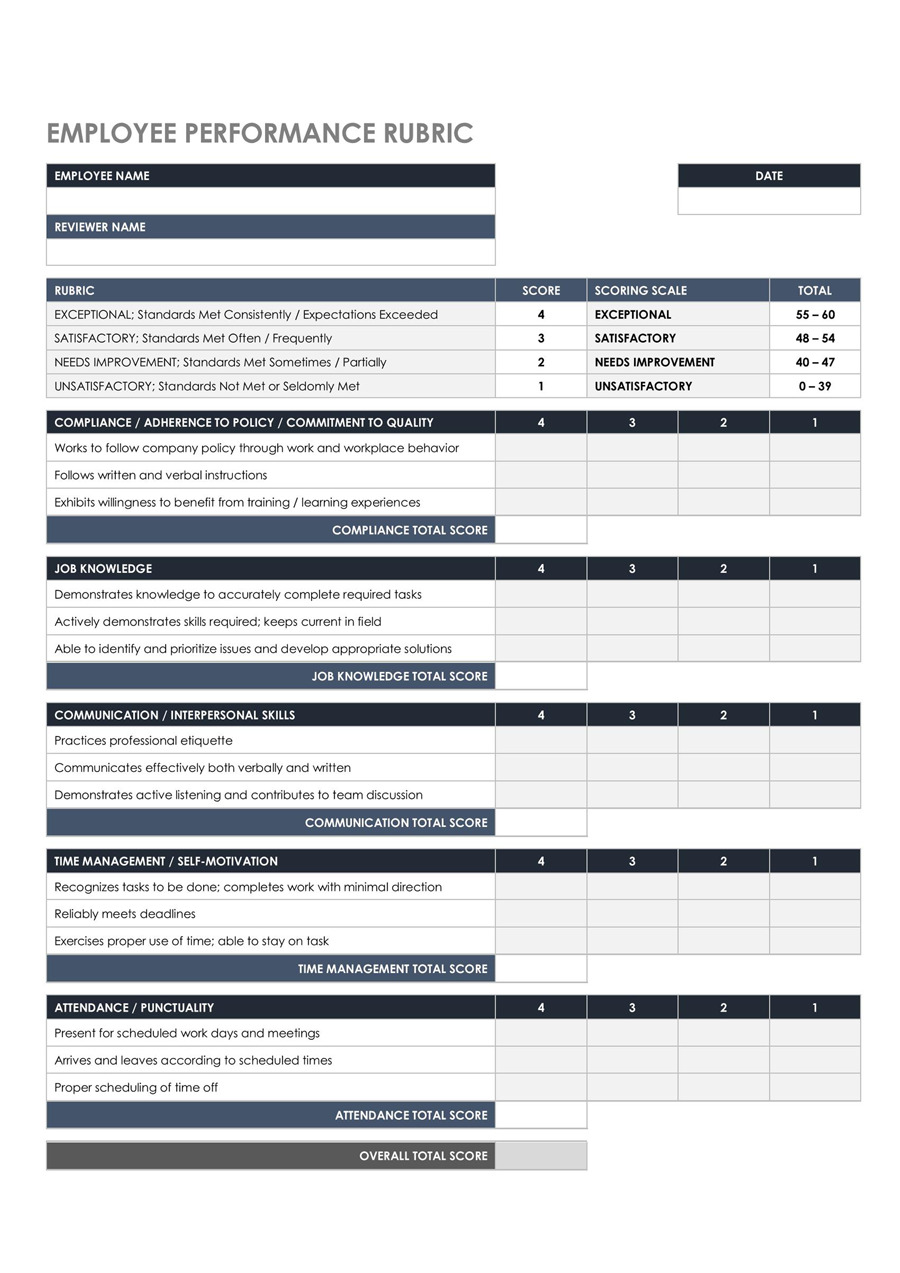
Employee performance assessment is essential for HR management and boosting productivity. An employee performance rubric will take into consideration teamwork, attendance, time management, leadership, and other aspects that influence productivity.
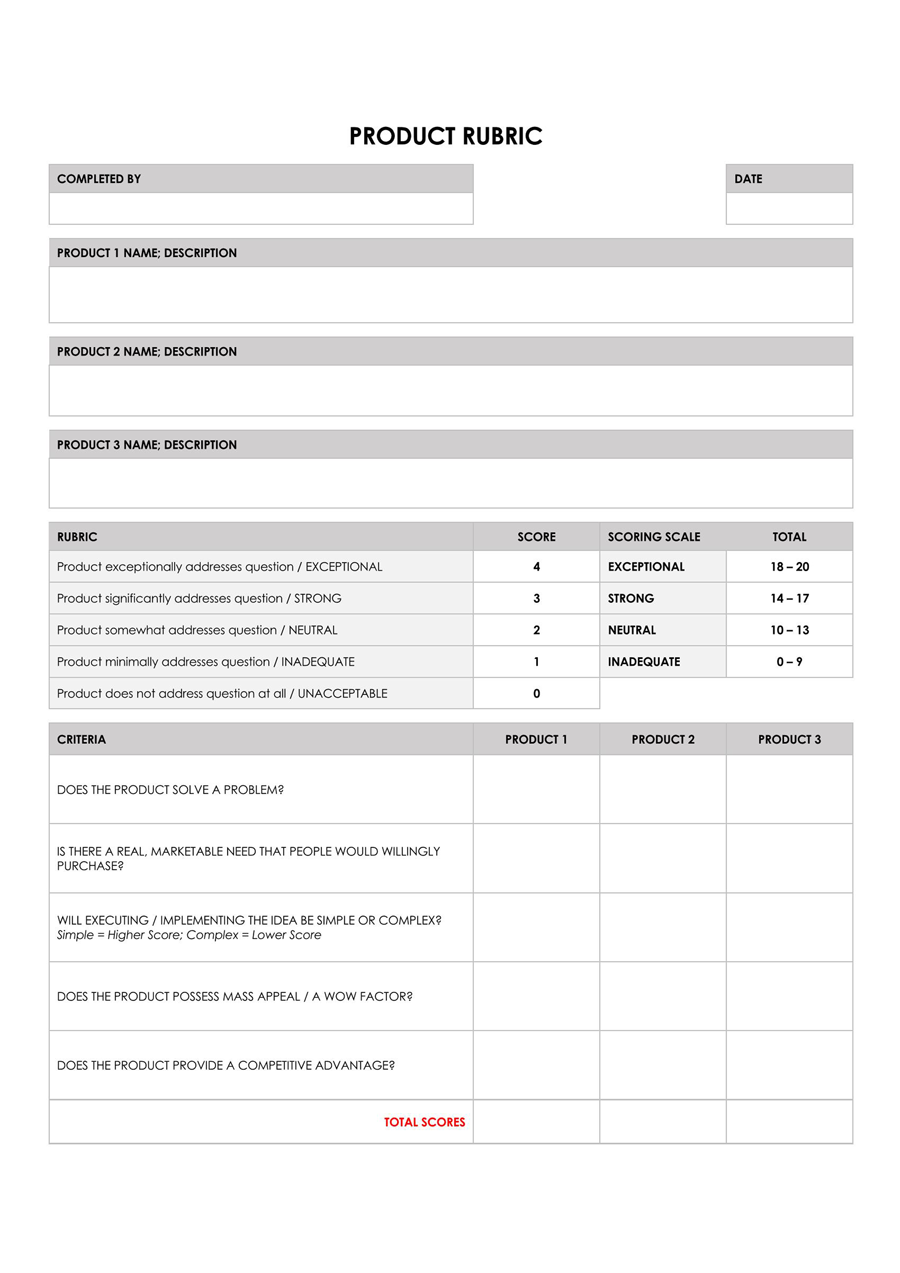
Rubrics can be used in product research and decision-making. A rubric is used to assess how a new product or intended purchase aligns with business objectives. Factors considered when assessing a product are viability, demand, RoI, and other benefits that can be realized by its introduction. The performance of the product can be ranked and compared to those of other products to determine which product is worth investing in, the most beneficial.
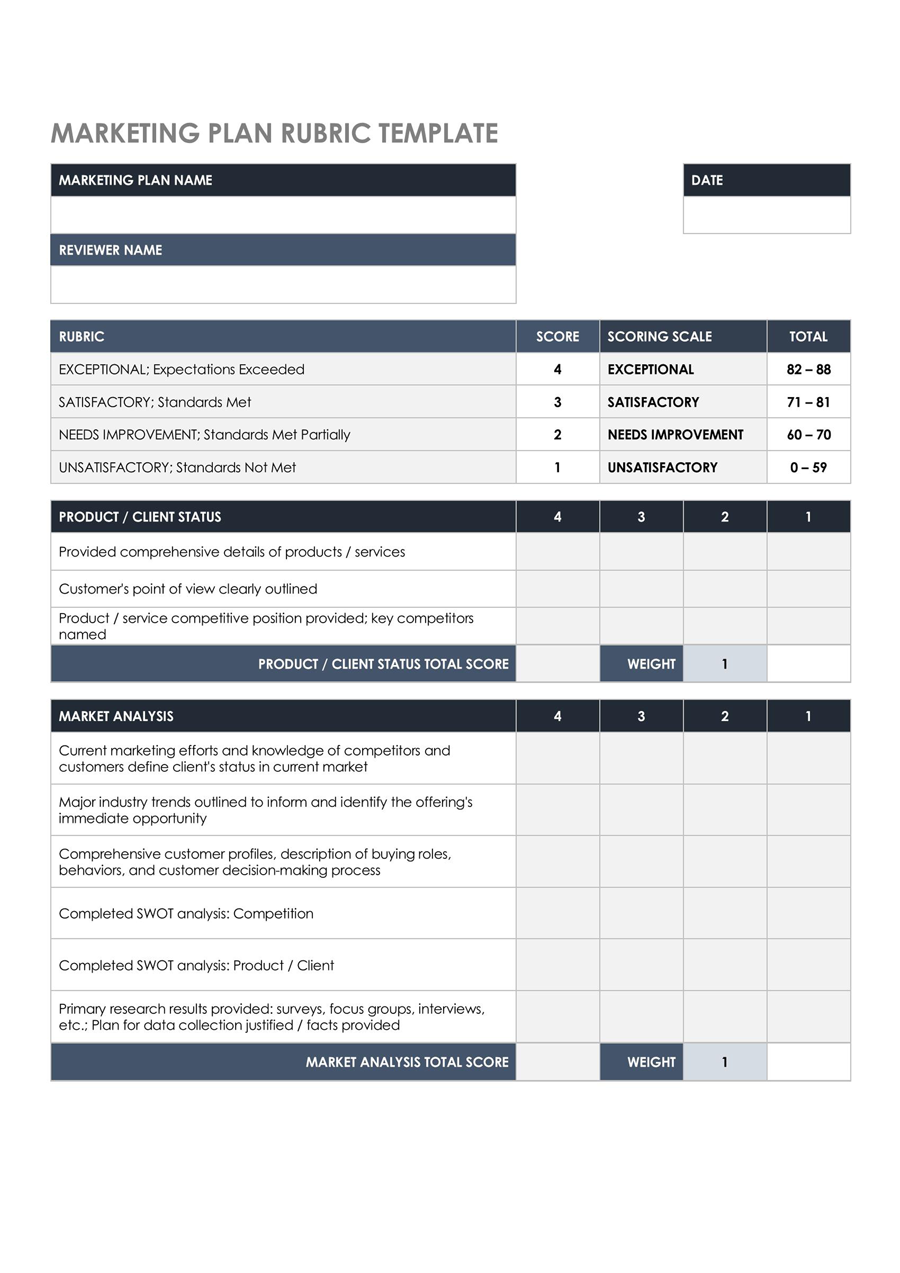
A marketing plan's success depends on multiple factors that can be assessed with a rubrics template. The rubric can evaluate how action items influence results and grade their performance. The overall score of the marketing plan is an indication of its effectiveness and can be used to determine areas of improvement.
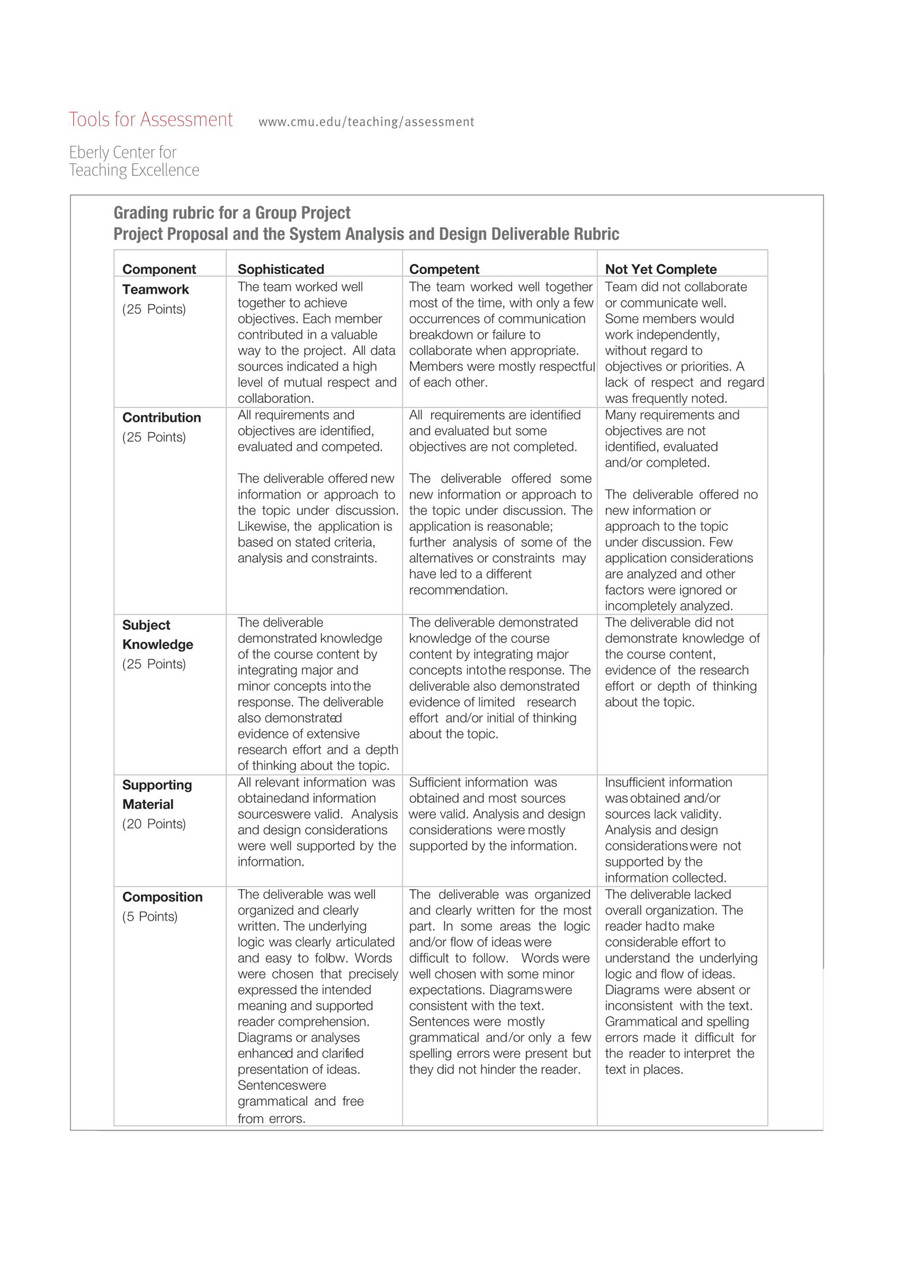
A group project rubric is used to assess the performance of a group of individuals assigned the same task. The rubric considers factors such as teamwork, member contributions, subject knowledge, presentation skills, organization, content, and any other. A group project template is a simple tool for collectively assessing team members.
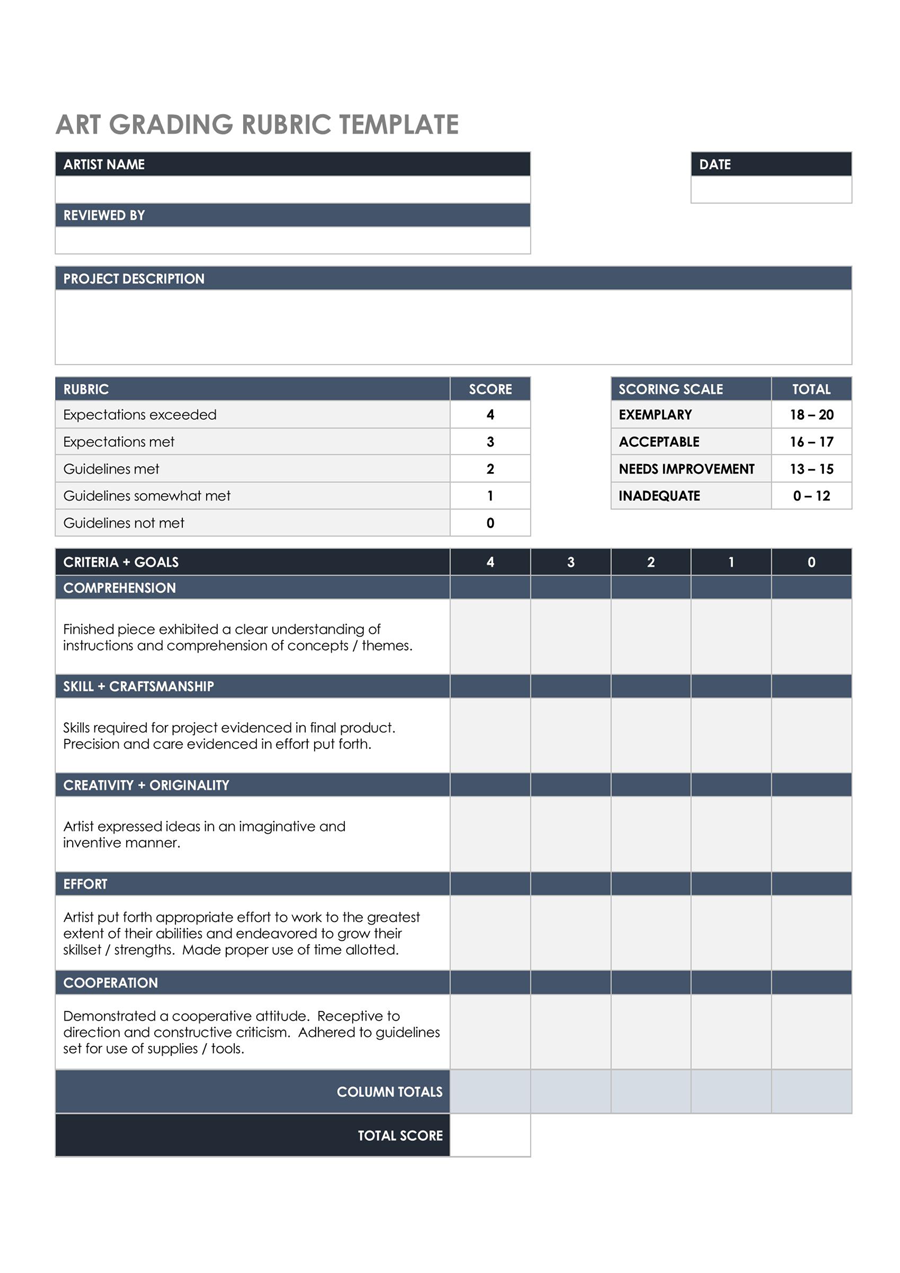
A type of rubric template used for grading art projects. It will cover aspects such as subject comprehension, skill and craftsmanship, originality, creativity, and other criteria that can be used to grade art. This type of rubric template will vary depending on the type of art.
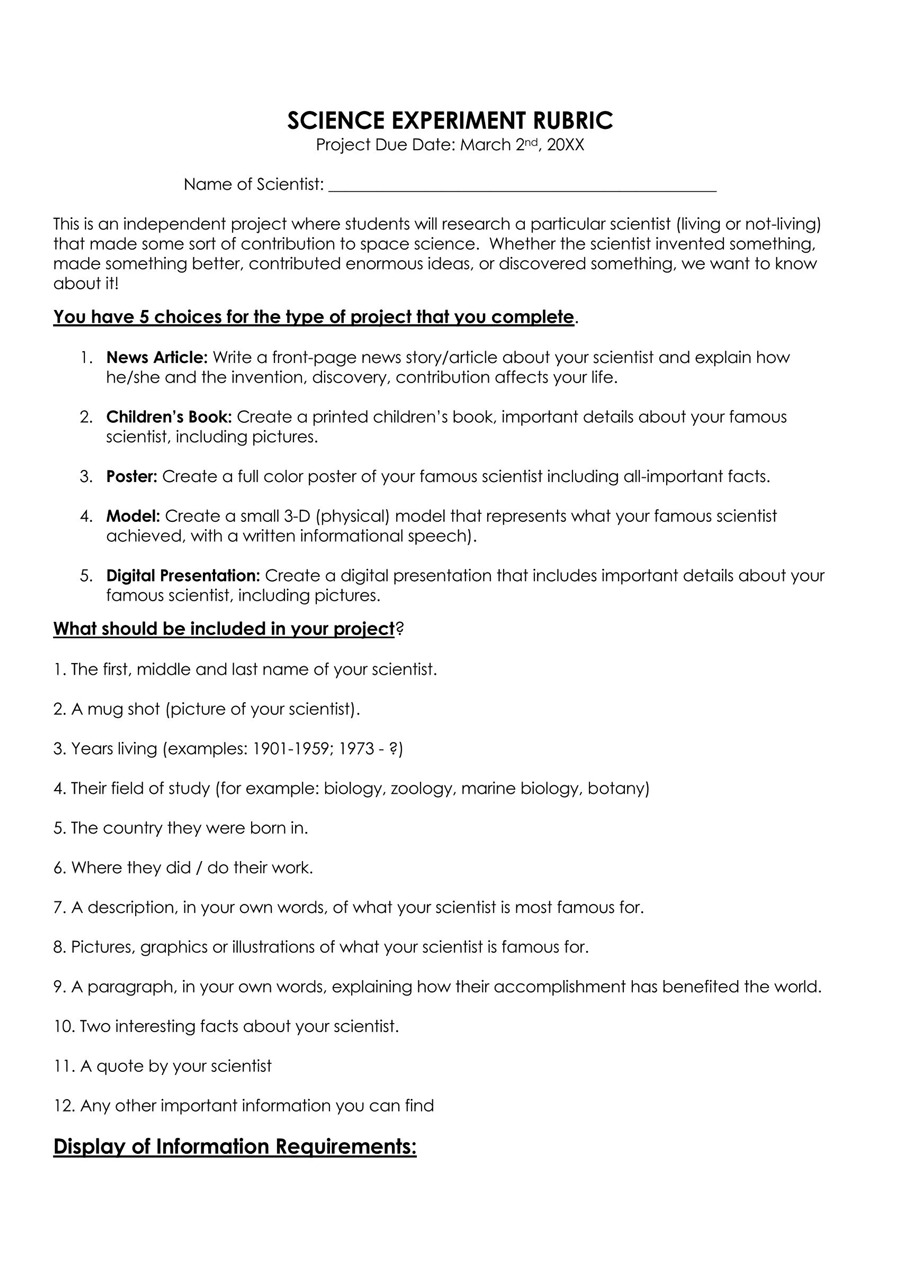
Science projects can be evaluated using rubrics. Examples of factors considered when assessing a science project are experimental hypothesis, design, materials, procedure, data collection, analysis, discussion, and presentation skills.
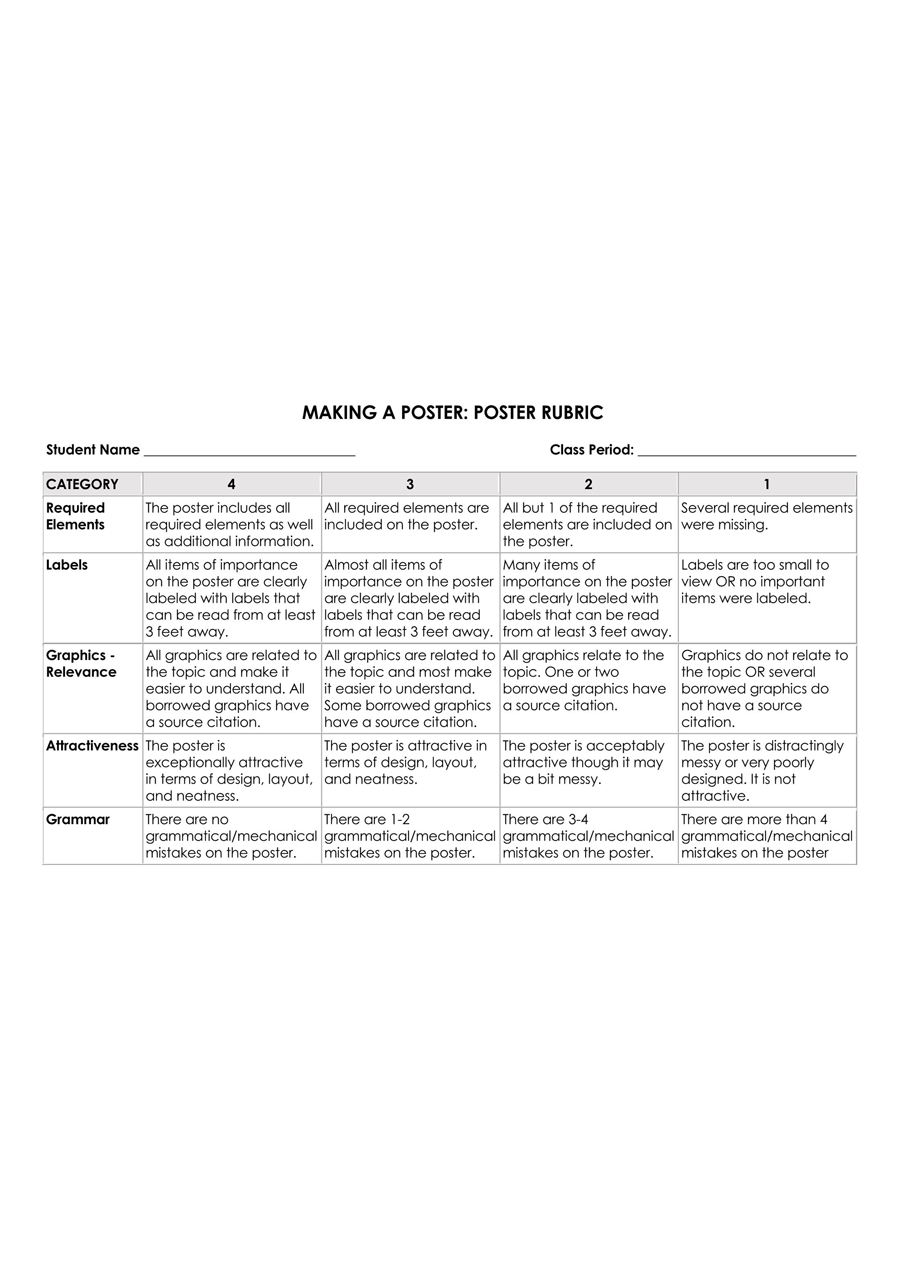
A poster rubric template is used to evaluate poster assignments, commonly utilized in elementary school. Criteria used include required components, graphics used, presentation appeal, creativity, content, and grammar. Students can grade each student accordingly.
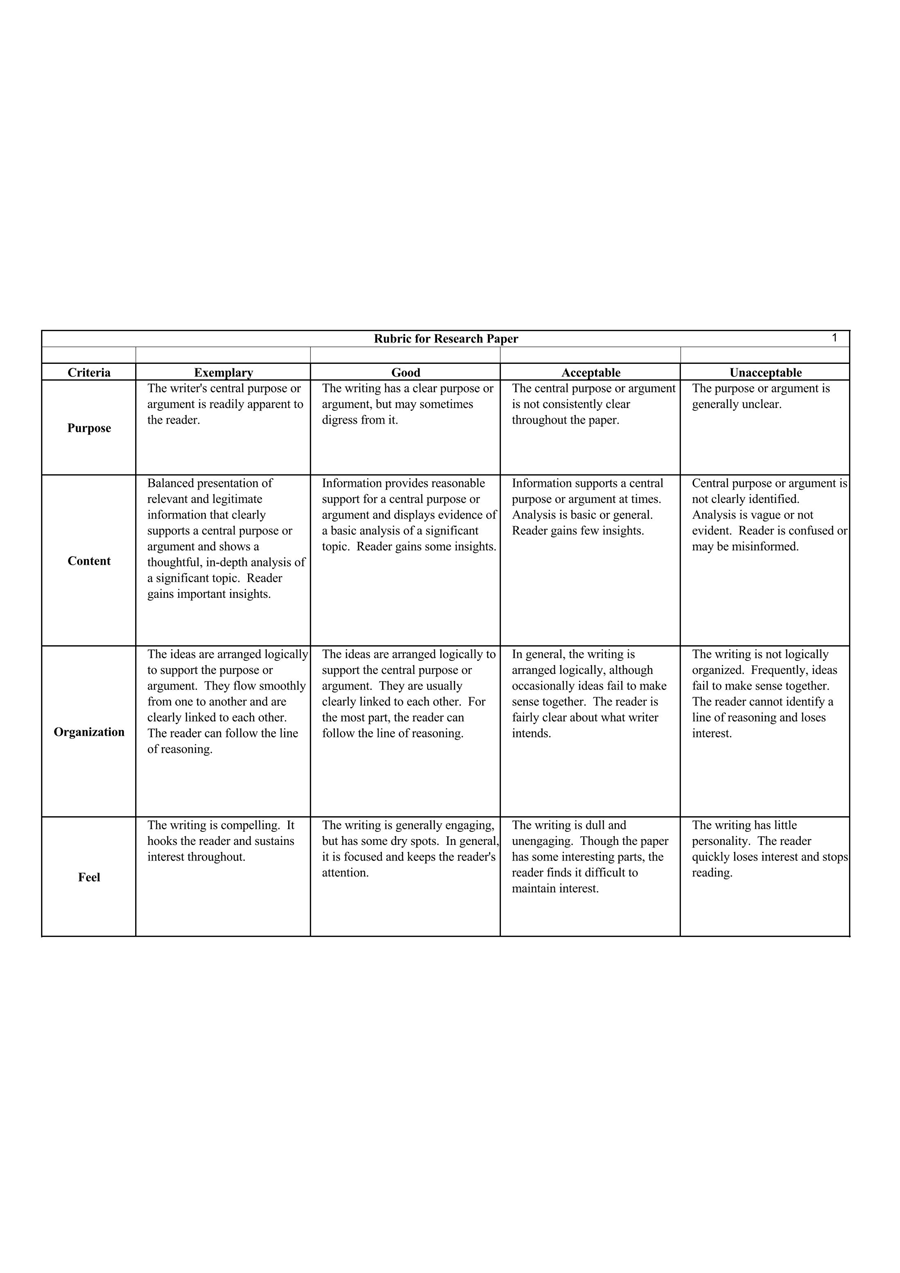
Rubrics can be used to evaluate and score research projects, written reports, and other written assignments such as dissertations, essays, etc. Common criteria used in research project rubrics include objectives, content, format and structure, writing skills, analytical skills, use of references, submission, etc.
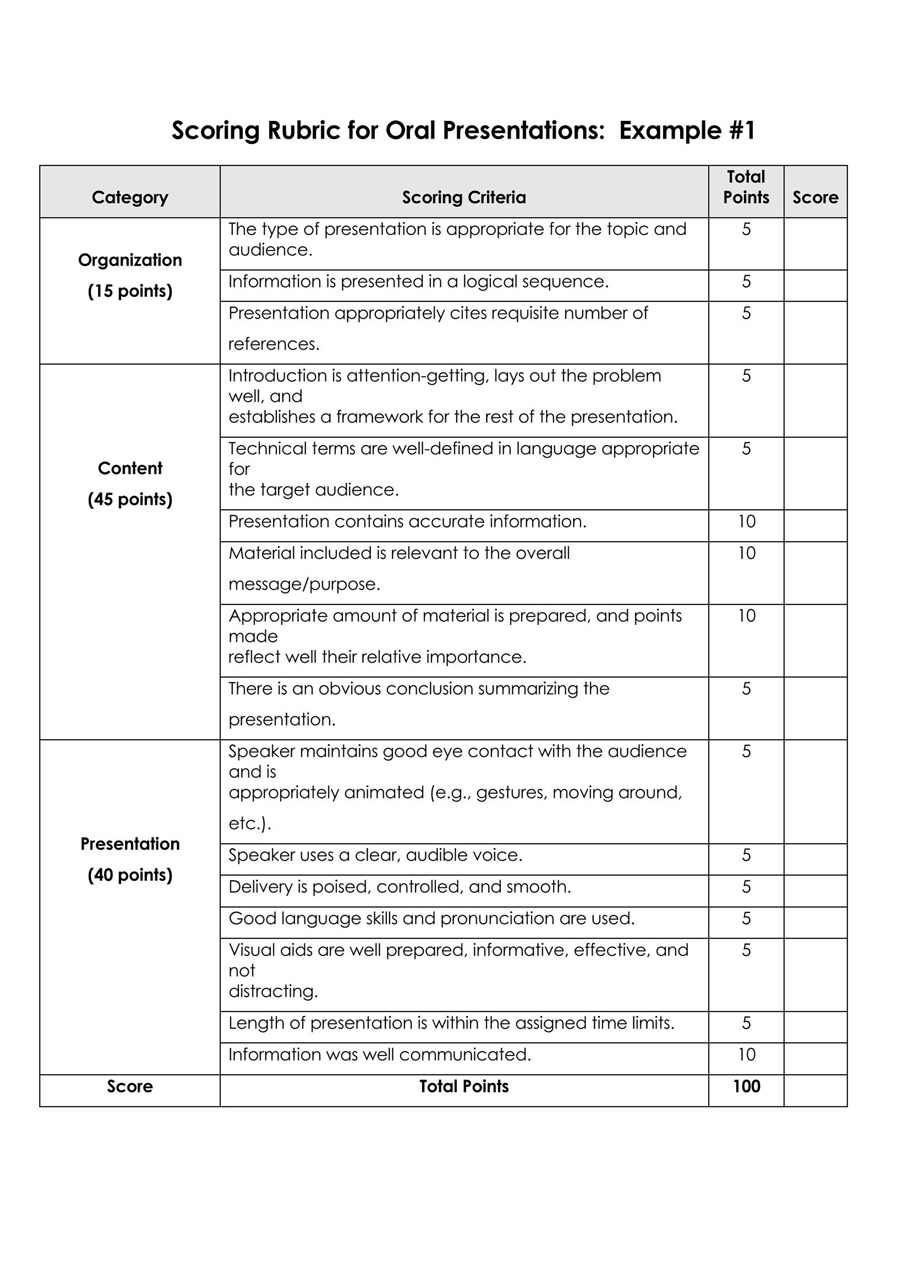
Presentation is a common means of reporting in both academic and business settings. The effectiveness of a presentation can be established through a rubric. Elements of a presentation that need to be assessed are oral communication and presentation skills, delivery, visual elements, organization, supporting material, etc. Rubrics can be used by lecturers, professors, and supervisors to grade presentations.
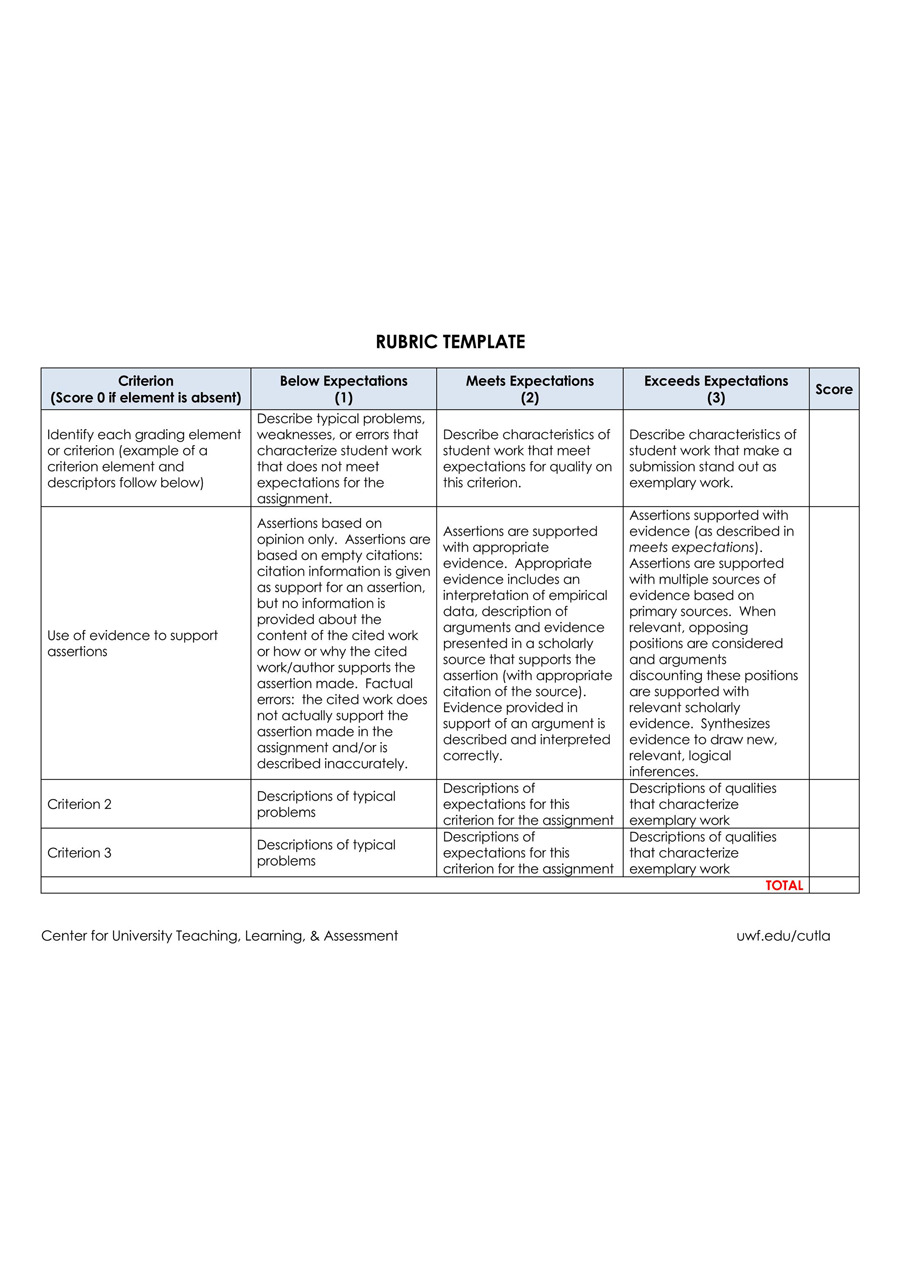
A type of rubric used to assess any type of project, assignment, or work performance. It covers the key elements of a performance success such as comprehension, skill, creativity, effort, cooperation, etc.
How to Create It?
A good rubric template has to be detailed to give an accurate assessment. It must outline all the elements while giving comprehensive descriptors.
Below are the steps for developing a template:
Create a task description
The first step is to identify the tasks or areas of assessment. The task description(s) indicate the actions that the student or employee is expected to complete and will often be influenced by the assessor’s objectives. Factors that determine the task description include the importance of each task, performance assessment procedure, level of feedback expected to be given, performance standards, and grading system to be adopted.
For a teacher, the task could be:
A ten-page book review of Romeo and Juliet.
Identify the criteria (rows)
Next, the assessor should identify the criteria they will use to assess the quality or grade of performance. Criteria are used to assess the student or employee’s level of skills and knowledge; identify at least four criteria and at most 7. Different assignments will have different criteria. Eliminate any non-crucial criteria.
The criteria can be grammar, originality, content, and clarity in the example above.
Determine a performance rating scale (columns)
Afterward, determine the grading system for the rubric template to assess the performance level at each work criterion. A performance rating scale should cover the following three levels of performance:
- Level 1: Level 1 represents the optimal expectations of the assessor. Therefore, the characteristics that describe the best work or meet the assessor’s expectations should be determined.
- Level 2: Level 2 should represent intermediate categories or levels of performance , which can be more than one. A description of the characteristics of these levels should be determined.
- Level 3: The last category of performance level should give characteristics of an unacceptable level of performance.
The performance rating scale can be given as; ranks such as numbers (1, 2, 3, 4) or grades (A, B, C) or as descriptors such as excellent, good, satisfactory, and needs improvement. The example given earlier can use these descriptors. Each character and definition of the performance levels should be mutually exclusive.
As a result, an even number of performance levels should be used to avoid categorizing levels with cross-over characteristics and descriptions. Performance levels should be supplied in the columns and must follow an order, preferably best to worst.
Write a description for each performance level
The assessor should then provide short, measurable, and specific descriptions or statements for each performance level. The description should be able to assess and categorize assignments that are being assessed. Ensure the template is limited to one page to make it easier to use.
Test rubric
The template is then tested by applying it to an assignment and sharing the assessment results with colleagues. Have them evaluate how effective the rubric is in grading performances based on shared organizational grading systems and shared expectations.
Get feedback and revise
Once feedback is obtained, review the template and incorporate any improvements required or remove any notable issues.
Smart Tips to Develop a Good Rubic
How well a rubric is developed influences the accuracy of its results (scores). Below are essential tips to keep in mind when creating one:
- Find and adapt an existing rubric: Due to the divergent expectations of different assessors, it is rare to find an existing one that highlights all the expectations of a project or assignment. While a project-specific can be created, it may take time. Therefore, it is always best to look for a closely resembling rubric, maybe from a colleague, and modify/adapt it to fit the situation.
- Evaluate the template: Review the template to add or remove. An effective one must relate to the assessor’s expectations and be feasible for the project. Irrelevant elements should be removed.
- Collect samples of student work: Collect samples of the student or employee performance that meet the expectations at each performance level to act as benchmarks or exemplars of quality at the different levels. Samples are essential for highlighting characteristics at different scale levels.
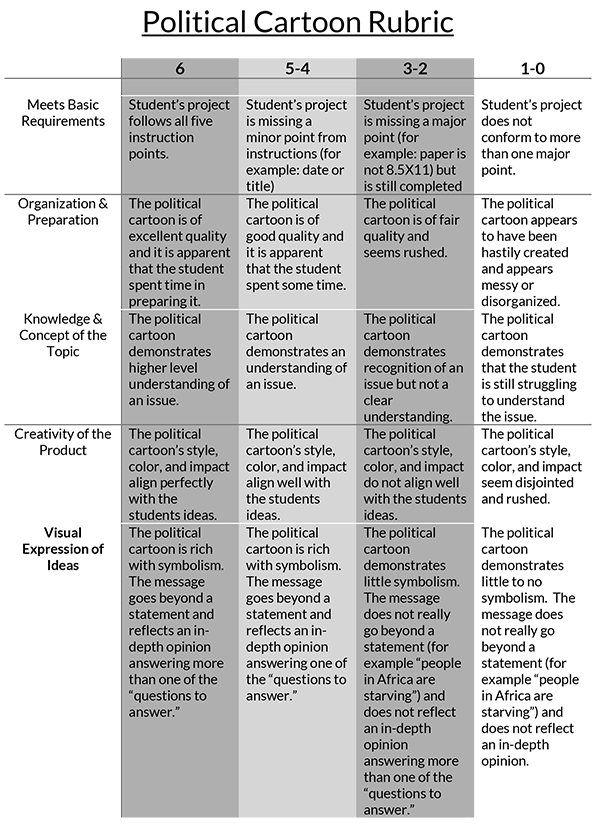
Pros and Cons of It
The use of rubrics has its advantages and disadvantages. This article will look at the pros and cons that teachers and employers should be aware of when assessing the performance of their students and employees, respectively.
One of the merits template is its ability to give feedback to the person being assessed. Feedback is a crucial element in helping students and employees identify their strengths and weaknesses and promoting growth in performance. Students and workers can know the areas that led to a poor assessment report and learn how to improve on these areas.
They promote metacognition development by promoting critical thinking among students and workers. Rubrics justify scores and grades, demonstrating that students earned their awarded grades rather than just being given them. This fosters better performances in the future as the person being assessed becomes aware of what is expected of them.
Rubrics are criterion-based rather than norm-based. This means they assess performance based on the set criteria rather than relativity – conscious or subconscious comparison with other works. By having criteria to measure performance, assessors can make better decisions and limit bias when awarding scores.
Fairness is integral in academics and business. Their use ensures a fixed set of standards is used in evaluating a student’s or employee’s performance. Therefore, regardless of how divergent the student’s or employee’s approach is, it is graded depending on how effectively it satisfies the assessor’s expectations.
There is no standard or fixed scale for rubrics. Assessors can use scales as they see fit, and in some cases, this may compromise its effectiveness. On extreme scales, too few or too many options lead to an ineffective one because too few options do not offer enough details. Too many options are difficult to interpret due to the negligible discrepancies between adjacent options.
They often use inconsistent language that may result in misinterpretations. It is recommended that parallelism and consistency be maintained throughout the description of each performance level.
For example, in a rubric that assesses the relevance of a paper to the topic, the levels can be described as follows:
- Level A – unimportant
- Level B – slightly unimportant
- Level C – moderately important
- Level D – important
The rubric has not used parallelism and consistency due to the combination of unimportant and essential definitions. A better one would be as follows:
- Level A – Least important
- Level B – moderately important
- Level C – important
- Level D – most important
Rubrics that use solid or negative language such as “Not,” “Never,” or “None” to describe poor or low-level performances are known to counter their benefits as they tend to discourage students and workers. The use of slightly, minor, or un- is advocated for.
Sometimes they tend to be vague when defining the characteristics of each performance level. Criteria should be observable and measurable, and how these are achieved should be specified when describing each scale level.
A thesis that is always strong can be characterized as specific, original, and evidence-based. In contrast, a thesis that is usually substantial can be defined as defendable and evidence-based. The characteristic “originality” distinguishes the two without relying on the subjective terms “always” and “usually.”

Key Takeaways
Assessments are necessary for academics and business. A rubric is an effective way of maintaining accurate and consistent student and employee performance records. They also help in offering feedback to the individuals being assessed. Therefore, more than an assessment tool, it is a communication tool between teachers/employers and students/workers.
About This Article

Was this helpful?
Great! Tell us more about your experience
Not up to par help us fix it, keep reading.

Business , Planners
25 effective work plan templates | excel – word.

Business , Invoices
9+ best catering invoice templates for decor business.

Free Tree Service Estimate Templates

Checklist , Real Estate
Free estate planning checklist (how to plan) – word | pdf, thank you for your feedback.
Your Voice, Our Progress. Your feedback matters a lot to us.
- help_outline help
iRubric: Entrepreneurship Business Plan - Final Project Rubric
| Rubric Code: By Ready to use Public Rubric Subject: Type: Grade Levels: 9-12 |
| Business Plan Capstone Project | |||||
| | |||||
| | |||||
| | |||||
| | |||||
| | |||||
| | |||||
| | |||||
| | |||||
| | |||||
- Entrepreneurial Business Plan
Rubric Best Practices, Examples, and Templates
A rubric is a scoring tool that identifies the different criteria relevant to an assignment, assessment, or learning outcome and states the possible levels of achievement in a specific, clear, and objective way. Use rubrics to assess project-based student work including essays, group projects, creative endeavors, and oral presentations.
Rubrics can help instructors communicate expectations to students and assess student work fairly, consistently and efficiently. Rubrics can provide students with informative feedback on their strengths and weaknesses so that they can reflect on their performance and work on areas that need improvement.
How to Get Started
Best practices, moodle how-to guides.
- Workshop Recording (Spring 2024)
- Workshop Registration
Step 1: Analyze the assignment
The first step in the rubric creation process is to analyze the assignment or assessment for which you are creating a rubric. To do this, consider the following questions:
- What is the purpose of the assignment and your feedback? What do you want students to demonstrate through the completion of this assignment (i.e. what are the learning objectives measured by it)? Is it a summative assessment, or will students use the feedback to create an improved product?
- Does the assignment break down into different or smaller tasks? Are these tasks equally important as the main assignment?
- What would an “excellent” assignment look like? An “acceptable” assignment? One that still needs major work?
- How detailed do you want the feedback you give students to be? Do you want/need to give them a grade?
Step 2: Decide what kind of rubric you will use
Types of rubrics: holistic, analytic/descriptive, single-point
Holistic Rubric. A holistic rubric includes all the criteria (such as clarity, organization, mechanics, etc.) to be considered together and included in a single evaluation. With a holistic rubric, the rater or grader assigns a single score based on an overall judgment of the student’s work, using descriptions of each performance level to assign the score.
Advantages of holistic rubrics:
- Can p lace an emphasis on what learners can demonstrate rather than what they cannot
- Save grader time by minimizing the number of evaluations to be made for each student
- Can be used consistently across raters, provided they have all been trained
Disadvantages of holistic rubrics:
- Provide less specific feedback than analytic/descriptive rubrics
- Can be difficult to choose a score when a student’s work is at varying levels across the criteria
- Any weighting of c riteria cannot be indicated in the rubric
Analytic/Descriptive Rubric . An analytic or descriptive rubric often takes the form of a table with the criteria listed in the left column and with levels of performance listed across the top row. Each cell contains a description of what the specified criterion looks like at a given level of performance. Each of the criteria is scored individually.
Advantages of analytic rubrics:
- Provide detailed feedback on areas of strength or weakness
- Each criterion can be weighted to reflect its relative importance
Disadvantages of analytic rubrics:
- More time-consuming to create and use than a holistic rubric
- May not be used consistently across raters unless the cells are well defined
- May result in giving less personalized feedback
Single-Point Rubric . A single-point rubric is breaks down the components of an assignment into different criteria, but instead of describing different levels of performance, only the “proficient” level is described. Feedback space is provided for instructors to give individualized comments to help students improve and/or show where they excelled beyond the proficiency descriptors.
Advantages of single-point rubrics:
- Easier to create than an analytic/descriptive rubric
- Perhaps more likely that students will read the descriptors
- Areas of concern and excellence are open-ended
- May removes a focus on the grade/points
- May increase student creativity in project-based assignments
Disadvantage of analytic rubrics: Requires more work for instructors writing feedback
Step 3 (Optional): Look for templates and examples.
You might Google, “Rubric for persuasive essay at the college level” and see if there are any publicly available examples to start from. Ask your colleagues if they have used a rubric for a similar assignment. Some examples are also available at the end of this article. These rubrics can be a great starting point for you, but consider steps 3, 4, and 5 below to ensure that the rubric matches your assignment description, learning objectives and expectations.
Step 4: Define the assignment criteria
Make a list of the knowledge and skills are you measuring with the assignment/assessment Refer to your stated learning objectives, the assignment instructions, past examples of student work, etc. for help.
Helpful strategies for defining grading criteria:
- Collaborate with co-instructors, teaching assistants, and other colleagues
- Brainstorm and discuss with students
- Can they be observed and measured?
- Are they important and essential?
- Are they distinct from other criteria?
- Are they phrased in precise, unambiguous language?
- Revise the criteria as needed
- Consider whether some are more important than others, and how you will weight them.
Step 5: Design the rating scale
Most ratings scales include between 3 and 5 levels. Consider the following questions when designing your rating scale:
- Given what students are able to demonstrate in this assignment/assessment, what are the possible levels of achievement?
- How many levels would you like to include (more levels means more detailed descriptions)
- Will you use numbers and/or descriptive labels for each level of performance? (for example 5, 4, 3, 2, 1 and/or Exceeds expectations, Accomplished, Proficient, Developing, Beginning, etc.)
- Don’t use too many columns, and recognize that some criteria can have more columns that others . The rubric needs to be comprehensible and organized. Pick the right amount of columns so that the criteria flow logically and naturally across levels.
Step 6: Write descriptions for each level of the rating scale
Artificial Intelligence tools like Chat GPT have proven to be useful tools for creating a rubric. You will want to engineer your prompt that you provide the AI assistant to ensure you get what you want. For example, you might provide the assignment description, the criteria you feel are important, and the number of levels of performance you want in your prompt. Use the results as a starting point, and adjust the descriptions as needed.
Building a rubric from scratch
For a single-point rubric , describe what would be considered “proficient,” i.e. B-level work, and provide that description. You might also include suggestions for students outside of the actual rubric about how they might surpass proficient-level work.
For analytic and holistic rubrics , c reate statements of expected performance at each level of the rubric.
- Consider what descriptor is appropriate for each criteria, e.g., presence vs absence, complete vs incomplete, many vs none, major vs minor, consistent vs inconsistent, always vs never. If you have an indicator described in one level, it will need to be described in each level.
- You might start with the top/exemplary level. What does it look like when a student has achieved excellence for each/every criterion? Then, look at the “bottom” level. What does it look like when a student has not achieved the learning goals in any way? Then, complete the in-between levels.
- For an analytic rubric , do this for each particular criterion of the rubric so that every cell in the table is filled. These descriptions help students understand your expectations and their performance in regard to those expectations.
Well-written descriptions:
- Describe observable and measurable behavior
- Use parallel language across the scale
- Indicate the degree to which the standards are met
Step 7: Create your rubric
Create your rubric in a table or spreadsheet in Word, Google Docs, Sheets, etc., and then transfer it by typing it into Moodle. You can also use online tools to create the rubric, but you will still have to type the criteria, indicators, levels, etc., into Moodle. Rubric creators: Rubistar , iRubric
Step 8: Pilot-test your rubric
Prior to implementing your rubric on a live course, obtain feedback from:
- Teacher assistants
Try out your new rubric on a sample of student work. After you pilot-test your rubric, analyze the results to consider its effectiveness and revise accordingly.
- Limit the rubric to a single page for reading and grading ease
- Use parallel language . Use similar language and syntax/wording from column to column. Make sure that the rubric can be easily read from left to right or vice versa.
- Use student-friendly language . Make sure the language is learning-level appropriate. If you use academic language or concepts, you will need to teach those concepts.
- Share and discuss the rubric with your students . Students should understand that the rubric is there to help them learn, reflect, and self-assess. If students use a rubric, they will understand the expectations and their relevance to learning.
- Consider scalability and reusability of rubrics. Create rubric templates that you can alter as needed for multiple assignments.
- Maximize the descriptiveness of your language. Avoid words like “good” and “excellent.” For example, instead of saying, “uses excellent sources,” you might describe what makes a resource excellent so that students will know. You might also consider reducing the reliance on quantity, such as a number of allowable misspelled words. Focus instead, for example, on how distracting any spelling errors are.
Example of an analytic rubric for a final paper
| Above Average (4) | Sufficient (3) | Developing (2) | Needs improvement (1) | |
|---|---|---|---|---|
| (Thesis supported by relevant information and ideas | The central purpose of the student work is clear and supporting ideas always are always well-focused. Details are relevant, enrich the work. | The central purpose of the student work is clear and ideas are almost always focused in a way that supports the thesis. Relevant details illustrate the author’s ideas. | The central purpose of the student work is identified. Ideas are mostly focused in a way that supports the thesis. | The purpose of the student work is not well-defined. A number of central ideas do not support the thesis. Thoughts appear disconnected. |
| (Sequencing of elements/ ideas) | Information and ideas are presented in a logical sequence which flows naturally and is engaging to the audience. | Information and ideas are presented in a logical sequence which is followed by the reader with little or no difficulty. | Information and ideas are presented in an order that the audience can mostly follow. | Information and ideas are poorly sequenced. The audience has difficulty following the thread of thought. |
| (Correctness of grammar and spelling) | Minimal to no distracting errors in grammar and spelling. | The readability of the work is only slightly interrupted by spelling and/or grammatical errors. | Grammatical and/or spelling errors distract from the work. | The readability of the work is seriously hampered by spelling and/or grammatical errors. |
Example of a holistic rubric for a final paper
| The audience is able to easily identify the central message of the work and is engaged by the paper’s clear focus and relevant details. Information is presented logically and naturally. There are minimal to no distracting errors in grammar and spelling. : The audience is easily able to identify the focus of the student work which is supported by relevant ideas and supporting details. Information is presented in a logical manner that is easily followed. The readability of the work is only slightly interrupted by errors. : The audience can identify the central purpose of the student work without little difficulty and supporting ideas are present and clear. The information is presented in an orderly fashion that can be followed with little difficulty. Grammatical and spelling errors distract from the work. : The audience cannot clearly or easily identify the central ideas or purpose of the student work. Information is presented in a disorganized fashion causing the audience to have difficulty following the author’s ideas. The readability of the work is seriously hampered by errors. |
Single-Point Rubric
| Advanced (evidence of exceeding standards) | Criteria described a proficient level | Concerns (things that need work) |
|---|---|---|
| Criteria #1: Description reflecting achievement of proficient level of performance | ||
| Criteria #2: Description reflecting achievement of proficient level of performance | ||
| Criteria #3: Description reflecting achievement of proficient level of performance | ||
| Criteria #4: Description reflecting achievement of proficient level of performance | ||
| 90-100 points | 80-90 points | <80 points |
More examples:
- Single Point Rubric Template ( variation )
- Analytic Rubric Template make a copy to edit
- A Rubric for Rubrics
- Bank of Online Discussion Rubrics in different formats
- Mathematical Presentations Descriptive Rubric
- Math Proof Assessment Rubric
- Kansas State Sample Rubrics
- Design Single Point Rubric
Technology Tools: Rubrics in Moodle
- Moodle Docs: Rubrics
- Moodle Docs: Grading Guide (use for single-point rubrics)
Tools with rubrics (other than Moodle)
- Google Assignments
- Turnitin Assignments: Rubric or Grading Form
Other resources
- DePaul University (n.d.). Rubrics .
- Gonzalez, J. (2014). Know your terms: Holistic, Analytic, and Single-Point Rubrics . Cult of Pedagogy.
- Goodrich, H. (1996). Understanding rubrics . Teaching for Authentic Student Performance, 54 (4), 14-17. Retrieved from
- Miller, A. (2012). Tame the beast: tips for designing and using rubrics.
- Ragupathi, K., Lee, A. (2020). Beyond Fairness and Consistency in Grading: The Role of Rubrics in Higher Education. In: Sanger, C., Gleason, N. (eds) Diversity and Inclusion in Global Higher Education. Palgrave Macmillan, Singapore.
Business Plan Rubric
Related documents.
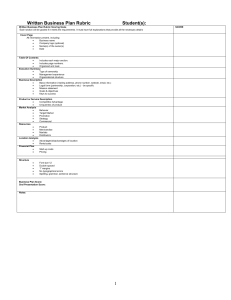
Study collections
- Donna Casilla
- ftdo business
Add this document to collection(s)
You can add this document to your study collection(s)
Add this document to saved
You can add this document to your saved list
Suggest us how to improve StudyLib
(For complaints, use another form )
Input it if you want to receive answer
Discover your ROI with ServiceTitan : Calculate Now
Explore our products
Servicetitan, fieldroutes, get more with pro, marketing pro, pricebook pro, scheduling pro, dispatch pro.
Power your business with a platform designed to give you workflows that encourage productivity.
Residential
Empower your team, gain more insights, and impress homeowners at every part of the job cycle.
Optimize cashflow
Automate your billing processes and reduce overhead costs
Increase productivity
Drive productivity with automated systems and processes that motivate your people
Win more business
Generate more revenue by monitoring pipeline and responding faster to incoming work orders
By Features
Front office features, field ops features, client experience features, management & insights features, maximize business performance.
Accelerate revenue and boost profitability with an all-in-one configurable platform
Grow profitably and scale
Fuel growth by identifying opportunities, improving processes, and replicating success
Deliver customer experience
Coordination, communication, and financing optimized from the same powerful platform
Customer Experience Features
Hvac software, plumbing software, electrician software, garage door, chimney sweep, commercial cleaning, water treatment, pest control.
Why ServiceTitan
Comparisons
Titanadvisor, marketplace, titan intelligence, the toolbox.
A place for contractors to access the best content — articles, webinars, podcasts, industry-leading voices and expert advice, all in one place!
Business Tips
Locksmith, Technician Tips, Guides
Locksmith Business Plan [What to Include + Free Template]
ServiceTitan Software
ServiceTitan is a comprehensive software solution built specifically to help service companies streamline their operations, boost revenue, and substantially elevate the trajectory of their business. Our comprehensive, cloud-based platform is used by thousands of electrical, HVAC, plumbing, garage door, and chimney sweep shops across the country—and has increased their revenue by an average of 25% in just their first year with us.
Related posts
Locksmith, Guides, Technician Tips
How to Start a Locksmith Business in 2024 [10-Step Guide]
Are you handy around the house and a quick problem solver? If so, you might be the perfect locksmith. In this guide, we’ll go over all the necessary steps for setting up shop ...
Locksmith, Operations, Technician Tips
10 of The Best Locksmith Blogs to Check Out
Below, we explore 10 reliable locksmith blogs run by people with deep locksmithing expertise or who are constantly interacting with locksmith business owners. We’ll explain e...
Locksmith, Marketing, Operations, Technician Tips
7 Effective Locksmith Business Card Ideas to Inspire You
Below is a curated list of great locksmith business card design templates to inspire you. We will explain how they work and explore other ways to market your company beyond bu...

IMAGES
VIDEO
COMMENTS
%PDF-1.6 %âãÏÓ 15 0 obj > endobj 60 0 obj >/Filter/FlateDecode/ID[4FBC0290F26945A580E439124278885D>]/Index[15 108]/Info 14 0 R/Length 138/Prev 88797/Root 16 0 R ...
Once your rubric is ready, you can begin evaluating business plans. Review each plan against the criteria, assign scores, and calculate the final scores based on the weightings. 9. Provide Feedback. After assessing the plans, offer constructive feedback to the entrepreneurs or teams behind them.
Global Perspective Rubric 13 . Written Communication Rubric 14 . Oral Presentation Rubric 15 . SUNY at New Paltz School of Business . Academic Presentation Skills Rubric 16 . Walton College . Business Plan Rubric 17 . California State University Sacramento . Also see 17 pages of undergraduate rubrics and 15 pages of graduate rubrics at . http ...
A rubric for evaluating business plans based on organization, paragraph construction, quality of information, internet use, mechanics, and product idea. Also includes rubrics for globalization research papers and webquest activities.
Use this template to create a research project, written report, or other writing assignment rubric. Assess a student's analytical and organizational skills, use of references, style and tone, and overall success of completing the assignment. The template includes room for additional comments about the student's work.
Written Business Plan Rubric Scoring Scale. Each section will be graded if it meets the requirements. It must have full explanations that provide all the necessary details. SCORE. Cover Page. All information present, including: · Business name. · Company logo (optional) · Name (s) of the owner (s)
Step #3: Conduct Your Market Analysis. Step #4: Research Your Competition. Step #5: Outline Your Products or Services. Step #6: Summarize Your Financial Plan. Step #7: Determine Your Marketing Strategy. Step #8: Showcase Your Organizational Chart. 14 Business Plan Templates to Help You Get Started.
Written Business Plan Rubric Scoring Scale Each section will be graded if it meets the requirements. It must have full explanations that provide all the necessary details. SCORE Cover Page All information present, including: · Business name
The business plan should be written by the owners of the venture, since it forces a firsthand examination of the business operations and allows them to focus on areas that need improvement. Refer to the business venture throughout the document. Generally speaking, a business plan should not be written in the first person. ...
And How to Create One. 1. Executive summary. This is a short section that introduces the business plan as a whole to the people who will be reading it, including investors, lenders, or other members of your team. Start with a sentence or two about your business, your goals for developing it, and why it will be successful.
iRubric N5B464: A planning document designed to detail the major characteristics of a small business - company description, marketing strategy, operations and financial overview - with an emphasis on the company's present and future. The intention is to focus the company, interest stakeholders and key investors to support the plan.. Free rubric builder and assessment tools.
RIA & SCORE SHEET Part 1: Business PlanExecutive Summary (10 Points) Number of points: ____Clear, exciting, and effective as a stand-alone overview of the pl. n; can be read in 5 minutes.Market and Competitive Analysis (10 Points) Number of points: ____Presents the growth trends and key driving forces of the industry; identifies the key ...
Download Simple Small-Business Plan Template. Word | PDF. This template walks you through each component of a small-business plan, including the company background, the introduction of the management team, market analysis, product or service offerings, a financial plan, and more. This template also comes with a built-in table of contents to ...
Business Plan Rubric Template. The performance of a business plan can be assessed using a rubrics template. Components of the business plan such as mission statement, market analysis, operational plan, financial plan are used as criteria and are rated based on their quality. ... Jill Newman is an expert in business writing with a wealth of ...
iRubric H92A96: Students develop a business plan for a business that they are personally interested in starting. Each student will be responsible for all portions of the comprehensive plan that covers everythnig, including Executive Summary, Business Description, writing a mission statement, developing the marketing plan, etc.. Free rubric builder and assessment tools.
The document outlines an entrepreneurship rubric for written business plans. It lists 11 sections that will be graded on a scale from the highest to lowest points. These sections include a cover page, table of contents, executive summary, business description, product/service description, market analysis, resources, location analysis, financial plan, simulation of business operations, and date ...
The document provides a rubric for evaluating written business plans and oral presentations on business plans. The rubric evaluates elements for both written and oral components. For written business plans, it evaluates sections including the cover page, table of contents, executive summary, business description, market analysis, financial plan, and formatting. For oral presentations, it ...
Presentation Guideline and Scoring Rubric for Business Plans. This competition challenges students to present well-developed business models and implementation plans. On the day of the competition, contestants must bring five printed copies of their presentation slides plus a one to two-page executive summary for review by the judges.
This rubric evaluates elements of a business plan on a scale from 1-4. It covers key sections including introductory elements, a business description, industry analysis, mission statement, and management plan. A proficient business plan includes all important details for each section, such as an overview of the company, competitive analysis, and clear explanation of ownership structure and goals.
Disadvantage of analytic rubrics: Requires more work for instructors writing feedback. Step 3 (Optional): Look for templates and examples. You might Google, "Rubric for persuasive essay at the college level" and see if there are any publicly available examples to start from. Ask your colleagues if they have used a rubric for a similar ...
The Business/Service Plan will be scored separately and represent 50% of the final competition score. The score will be based on the rubric below. The plan should follow the outline provided below. The oral presentation will represent the remaining 50% of the final score. The oral presentation should 12-15 minutes in duration with an additional ...
Business Plan Rubric - Free download as PDF File (.pdf), Text File (.txt) or read online for free. The document provides a rubric to evaluate business plans. It includes categories for organization, paragraph construction, quality of information, internet use, mechanics, product idea, and sources. Organization, paragraph construction, quality of information, and mechanics each receive a score ...
FINAL SCORE %. Business Plan Rubric Items. Marks Allotted. Executive Summary, Mission & Vision Statement, Logo, Slogan. 10. Description of the Business - Operations, location, Industry Analysis, Capacity, Procurement. 10. Business Goals and Objectives Description of product/s or Service/s. 10 10. D ...
ServiceTitan is a comprehensive software solution built specifically to help service companies streamline their operations, boost revenue, and substantially elevate the trajectory of their business. Our comprehensive, cloud-based platform is used by thousands of electrical, HVAC, plumbing, garage door, and chimney sweep shops across the country—and has increased their revenue by an average ...